ERA2 Treasury Portal User Guide v3 040224_EOUpdate_May2025
Emergency Rental Assistance Program (ERA2)
ERA2 Treasury Portal User Guide v3 040224_EOUpdate_May2025
OMB: 1505-0270
Emergency Rental Assistance Program (ERA2)
Treasury Portal User Guide
May
XX, 2025
v 4.0
Revision History
Version |
Date |
Updates |
V1.0 |
10/06/2023 |
Original |
V2.0 |
01/03/2024 |
Clarifications on Financial Reporting |
|
01/03/2024 |
Clarifications and descriptions of data validations for participant demographic Tables 1, 2, 3 and 4. |
V3.0 |
04/02/2024 |
Clarifications and description of data required on the Emergency Rental Assistance Project Data tab, and the Emergency Rental Assistance Project Participant Demographics Data tab, and related information. |
V4.0 |
05/XX/2025 |
Updates to reporting fields mandated by the President’s January 20, 2025 Executive Order 14168 titled, “Defending Women From Gender Ideology Extremism and Restoring Biological Truth to the Federal Government."
Clarifications of when the reporting system requires UEIs and TINS |
Table of Contents
Section I. Quarterly Reporting Basics 5
Section II. Navigation and Logistics 7
Section III. Recipient Profile Tab 19
Section IV. Project Overview Tab 24
Section V. Subrecipients, Contractors, and Beneficiaries Tab 45
Section VI. Recipient Subawards, Contracts and Direct Payments Tab 49
Section VII. Expenditures Tab 53
Section VIII. Project Data and Participant Demographics Tab 61
Section IX. Performance and Financial Reporting Tab 79
Section X. Report Certification and Submission Tab 86
Appendix A – Bulk File Upload Overview 89
Appendix C – Recipient Obligations and Expenditures (Payments) to Individuals (Beneficiaries) 110
Each ERA2 Recipient (ERA2 grantee) must submit Quarterly Reports with quarter-specific and cumulative performance and financial information. The reports must be submitted via Treasury’s portal.
This guide provides instructions and on using Treasury’s portal to submit required Emergency Rental Assistance (ERA2) Quarterly Reports. Much of the information in this guide is the same as provided in the earlier version of the Portal User Guide (which applied to both ERA1 and ERA2 programs), except for guidance on several new reporting requirements and updated reporting formats specific to the ERA2 program.
The guide is a supplement to the ERA2
Reporting Guidance which contains official guidance
on
reporting requirements.
Please also see Treasury’s ERA webpage for additional information on programmatic and reporting topics.
ERA2 Recipients must designate staff or officials for
three roles for developing and submitting the required ERA2 quarterly
reports. Recipients must provide the names and contact information
for persons designated for each of the three roles prior to accessing
their quarterly reports. The designations must be made on-line in
Treasury’s portal, as described below.
The required roles are as follows:
ERA2 Account Administrator for Reporting (AA) for the ERA2 award. Individuals designated for this role is responsible for working within your organization to determine its designees for the roles of Point of Contact for Reporting and Authorized Representative for Reporting and for inputting their names and contact information via Treasury’s portal and for making any changes or updates as needed over the ERA2 award period. The Account Administrator should identify an individual to serve in his/her place in the event of staff changes.
ERA2 Point of Contact for Reporting (POC) will receive official Treasury notifications about ERA2 reporting. Such notifications include alerts about upcoming reporting timeframes, requirements, and deadlines. Typically, the POC is a key individual for managing the ERA2 Recipient’s reporting. The POC can enter data into a report but cannot submit reports.
ERA2 Authorized Representative for Reporting (ARR) is responsible for certifying and submitting official reports on behalf of the ERA2 Recipient. Treasury will only accept reports or other official communications submitted by the ERA2 Authorized Representative for Reporting. The ARR is responsible for communications with Treasury on such matters as extension requests and amendments of previously submitted reports.
ERA2 reports include monthly reports, Quarterly Reports, interim reports, and final reports.
An ERA2 Recipient may designate multiple people to a single role or a single individual for multiple roles. For example, the individual designated as the ERA2 POC may also be designated as the ERA2 Authorized Representative for Reporting. The ERA2 Recipient may designate the same individual for all three roles.
Everyone who is designated by the ERA2 Recipient for any reporting role must register with ID.me or Login.gov before gaining access to Treasury’s portal. See the following links for registration instructions:
ID.me Guidance (Used by Recipient staff to apply for recovery act awards/assistance as well as to complete compliance reporting)
Login.gov Guidance (Used by Recipient staff to complete compliance reporting)
The names and contact information for the ERA2-designated individuals will be pre-populated in the “Recipient Profile” portion of the ERA2 Quarterly Reports. Recipients can update the designations and related information at any time. Please see the Hints and Tips for Designating Points of Contact for ERA1 and ERA2 Reporting for further details.
Individuals designated as an ERA2 Recipient’s ARR or AA are the only individuals with authority to certify and submit ERA2 Compliance Reports via Treasury’s portal. Staff serving as the ERA2 POC are not authorized to certify and submit ERA2 Compliance Reports. The POC is authorized only to enter data and validate the data on Treasury’s portal and to check draft data for submission errors and so forth.
Key terms appear in bold and are explained in the Data Dictionary posted on the Treasury’s ERA2 webpage.
Log in to Treasury’s Portal via login.gov (see Figure 1).
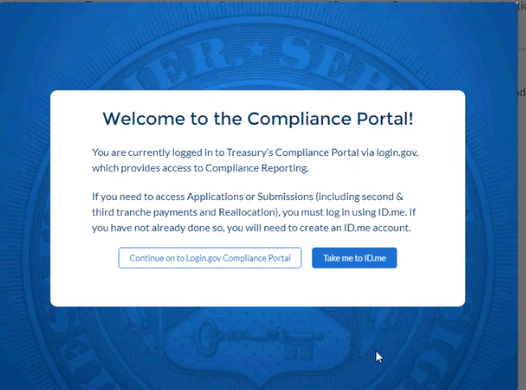
Upon logging in, navigate to the Introduction tab (see Figure 2).
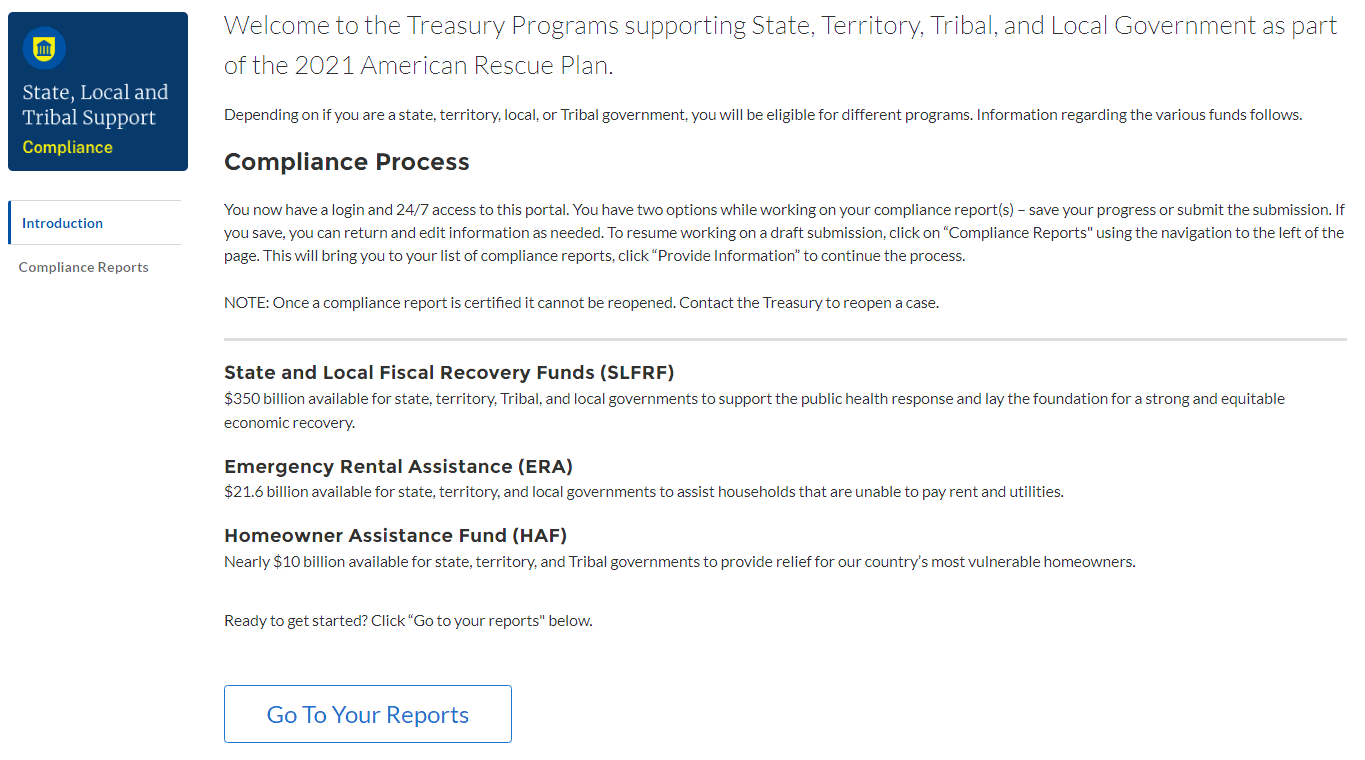
Click on the Compliance Reports tab (see Figure 3) to navigate to a window listing the of the ERA2 reports.

Figure 3 – Quarterly Report Selection
Each listed Quarterly Report links to the required online forms for the specific report. See Figure 3 above for an example Quarterly Report Selection screen.
To begin a report, click on the blue pencil icon under the “Provide Information” column to access the given report. The ERA Compliance Reports section lists all ERA reports. Reports in “Draft” status are available for data entry.
To navigate to a specific report, click the icon under Provide Information (see Figure 3) to enter data for the current report for the specific ERA2 Award. This action will advance you to the Reporting Guidance tab. The Reporting Guidance and Bulk Upload Templates and Instructions tabs are informational tabs. Recipient reporting begins with the Recipient Profile tab.
The Navigation Bar (see Figure 4) which appears on the left side of Treasury’s portal screens allows you to navigate between each tab.

On the right side of the screen, users will see another navigation pane with information about their ERA2 award (see Figure 5). This information box displays the status of the current report; the ERA2 award FAIN number; the ERA2 program CFDA number; the ERA2 Award Date; the Reporting Period for the specific quarterly report; the Reporting Period Start and End Dates; the Quarterly Report Submission Deadline; and the ERA2 Funds Allocated and the Current Total ERA2 Award Amount.
If the report has been submitted and the original submission deadline has not passed, the navigation bar displays an “unsubmit” button at the bottom of the display window. ERA2 Recipients that submit their quarterly report prior to the official due date can modify the submitted reports by clicking the “unsubmit” button. Clicking on “unsubmit” places the report into draft status so revisions and edits can be made prior to the due date. Only an ERA2 ARR or ERA AA can “unsubmit” reports.

Figure 5 – Project Information Navigation Pane
Treasury’s portal leads the ERA2 Recipient POC, ARR and AA through a series of online forms that, when completed, will fulfill the ERA2 Quarterly Reporting obligations. Users can manually enter data directly into the portal or, for many data elements, providing required information via a bulk upload file that includes all relevant information in a Treasury approved process and format.
Treasury encourages Recipients, particularly those with a large
quantity of data for reporting, to use the bulk upload functionality.
The bulk upload approach reduces Recipient administrative burden and
minimizes data entry errors. However, the manual data entry option is
available to all users and may be preferred by smaller programs with
less data to submit.
Bulk Upload Function
ERA2 Recipients can use bulk upload templates for providing much of the required information. The tabs and associated templates are listed below.
Please see Appendix A – Bulk Upload Overview for complete guidance on using the Bulk Upload function.
Subrecipients, Contractors and Beneficiaries Tab
Template #1 - Subrecipient, Contractor, Beneficiary Profile Template
Use this template to establish
records for all entities that initially became ERA2 award
subrecipients, contractors and beneficiaries in the current reporting
period.
Recipient Subawards, Contracts and Direct Payments Tab
Template #2 - Subaward, Contract, Direct Payment Record Template
Use
this template to establish records for all subawards, contracts, and
direct payments under the ERA2 award that were established initially
in the reporting period. This template can also be used to report
revisions to subawards, contracts, and direct payment obligations
established in prior periods.
Expenditures Tab
Template #3 - Reporting Expenditures associated with the Recipient’s Obligations valued at $30,000 or more Template.
Use this template to report expenditures made in the current reporting period that are associated with subawards, contracts and direct payments for which the Recipient obligated $30,000 or more.
Template #4 - Reporting Expenditures associated with the Recipient’s Obligations valued at less than $30,000 Template.
Use this template to report the aggregate amounts of obligations and expenditures made in the reporting period that are associated with subawards, contracts and direct payments for which the Recipient had obligated less than $30,000 to entities other than individuals. Expenditures must be classified by expenditure category.
Template #5 - Reporting Recipient Obligation and Expenditures to
Individuals Template
Use this
template to report the aggregate amounts the Recipient paid to
individuals in the reporting period. The aggregate amounts of
expenditures are classified by expenditure category.
Reporting on Templates 3, 4, and 5 should include new payments the Recipient made in the reporting period and prior period adjustments (increases or decreases) in the Recipient’s obligations and expenditures. Expenditures reported in prior periods cannot be directly edited or updated; however, Recipients can revise obligations and expenditures reported in prior periods by entering adjusting entries (increases or decreases) in the current reporting period either manually or using bulk upload Templates 3, 4, and 5.
NOTE: Beginning with the Q3 2023 quarterly report, the portal has not allowed bulk uploads of required information listed on the ERA2 Emergency Rental Assistance Project Data and Participant Demographics tab. ERA2 Recipients must manually enter Project Data and Participant Demographics for all quarterly reports starting with the Q3 2023 report.
Performance and Financial Reporting Tab
Template #7 - Participant Household Payment Data File Template
Use
this template to report information about each ERA2 Financial
Assistance payment made to or on behalf of each participant household
from the date of ERA2 award
through the end of the current reporting period.
All ERA2 Recipients are required to provide a Participant Household Payment Data File as part of each Quarterly Report. The Participant Household Payment Data File must be submitted as a “.csv” file upload; manual entry is not allowed for the Participant Household Payment Data file.
Please see Tip – Participant Household Payment Data File (Template 7) Guide and Checklist for more details on requirements and formatting of Template 7.
When using the bulk upload function, ERA2 Recipients must provide the required information in specified formats and use Treasury-approved templates for each respective bulk file upload. Templates must be downloaded individually on the Bulk Upload Templates and Instructions tab.
Recipients that use the bulk upload functionality must
download the current version of each bulk file upload template as an
early step in planning for the required Quarterly Report.
The template for each upload file is also available in the relevant tab for download (see Figure 6).
Tabs and components of the report accepting bulk upload files are clearly marked in Treasury’s portal and identified through this User Guide.

Figure 6 – Sample Bulk Upload Icon with Template Download Link
All bulk file templates download in the .xls format, but the templates must be saved in .csv format prior to upload. When you click the upload button users will be directed to a pop-up screen (see Figure 7) including basic instructions on uploading the file.
ERA2 Recipients can either choose to add files or drag and drop files
to initiate the bulk upload.
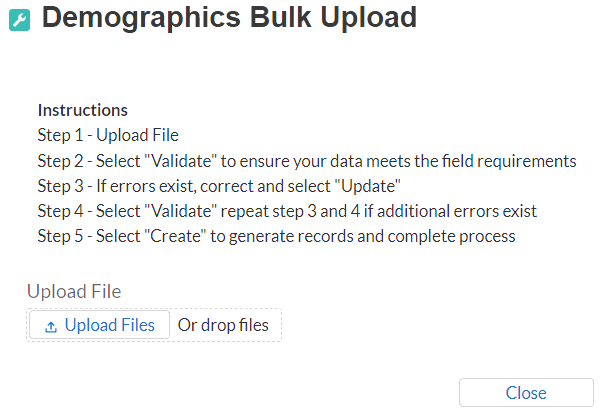
Figure 7 – Demographics Bulk Upload
Treasury’s ERA portal will reject a Bulk Upload File if it contains incorrect data (e.g., data not matching a picklist requirement) or if the file is not in “.csv” format. The portal will display an error message on screen if the bulk file upload data contains errors. When a user receives an error message(s), they must reconcile the errors in the bulk upload file and re-submit the corrected version to the portal. The user must “Validate” (step 4) each time they make new corrections until no errors remain in the Bulk Upload File. Then you will click “Import” to finalize.
Please see Appendix A – Bulk File Upload Overview for detailed instructions for using the bulk upload function.
There are three common Bulk File Upload errors as described below (see Figure 8):
Blank Data: Blank Data: When a required field is left blank within your bulk upload file, the specific bulk upload file row and cell number will be displayed on the screen. In the example below, the user made an error pertaining to the “Completion Status” and the error is in Column FF, Row 89.
Invalid Data: Invalid data includes any type of data (numeric or text) that does not meet the requirements set forth in the Help Text within each bulk upload file template. In the example below, the user made an error pertaining to the “Adopted Budget” and the error is in Column G, Row 9.
Duplicate Data: Duplicate data includes any type of data (numeric or text) that is repeated in the same column when the Help Text within a bulk upload file template requires a unique entry. For example, unique numbers should be provided for the project identification number. In the example below, the user made an error pertaining to the “Completion Status” and the error is in Column E, Row 8.
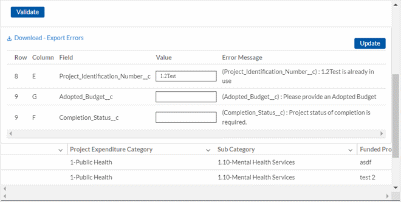
Figure 8 – Example Bulk Upload Errors
ERA2 Recipients that use manual data entry will key in information as instructed on the screen. Manual inputs are described in detail below for each section of this guide.
Note: * indicates a required field. You must enter information into the field before you can save or proceed to the next screen.
The portal will review manually inputted data to ascertain that the data provided is consistent with expected format or description (e.g., entering “one hundred” instead of 100). If a given data entry fails a validation rule, the portal will display an error message for you to address (see Figure 9).

Figure 9 – Manual Entry Error Example
After Treasury’s portal validates the data that has been manually entered for a given tab, the user may continue to the next tab. The portal will display an error notification for those elements that fail the validation rules (For example: leaving a required field as blank). The portal will alert users who manually enter a data value that does not satisfy the validation rules (For example, trying to enter a currency value beyond a specific range).
Clickable Icons
Some data entry areas will have an icon (see Figure 10) that will allow users to Provide Information (enter data), View information (previous data entries), or Download information (previous data entries).
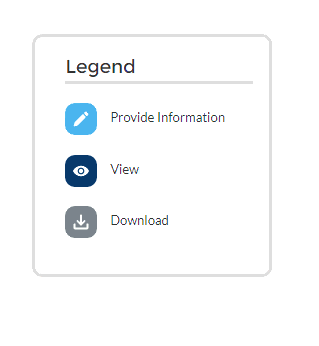
Figure 10 – Clickable Icons Legend
When providing narratives, type the responses using a word processing system (such as Microsoft Word) to minimize grammatical errors, track word count, and concisely answer all required narrative details. Users can copy and paste the final narratives directly into the text boxes in Treasury’s portal.
Users can expand a text box (see Figure 11) by clicking and dragging the icon in the bottom-right corner.
![]()
Figure 11 – Manual Entry Text Box
Saving Data
Within each tab of Treasury’s portal, users will see a next button and a save button at the bottom of each section or at the bottom of the screen.
Clicking the “Save” button will allow users to save current progress without advancing to the next module. Users can click the “Save” button when they plan to exit the portal and come back to the report later.
Clicking the “Next” button will automatically save
all information entered on that screen and advance the user to the
next tab. When a user clicks “Next” the screen will
display a green notification across the top of the screen to indicate
the report is successfully saved (see Figure 12).
Uploading and Deleting Word, Excel, and PDF Documents
After a user has uploaded a file in either Word or PDF format, the user will see the file Title and Upload Date populate within the relevant section. To view the uploaded file, click the “View Uploaded File” button (see Figure 13). Users may upload multiple files in each section.

Figure 13 – File Upload Functionality
Users can delete a previously uploaded file on the “Performance and Financial Reporting” tabs by clicking the check box next to the Title of the file to be deleted. A red “Delete Files” button will appear above the file (see Figure 14). Click the Delete File button to delete the selected file.

Figure
14 – Deleting Uploaded Files
Report Processing Information
This
section of the User Guide provides information on submitting a
report, editing a report prior to submission, and editing a report
after submission.
Maintaining a copy of the submitted report.
Treasury’s portal currently enables ERA2 Recipients to download a Zipped file that includes a suite of documents including a document in PDF format that contains key components of the submitted reports and several files in Excel format that contain details on amounts obligated and expended as well as the Participant Household Payment Data File. To access the Zipped document, after submitting the report, users should click on the icon under the “download” heading. The download for ERA2 Recipients whose quarterly report contains a large amount of data will be in the form of a downloadable file in Zip format.
Note: As currently configured, the downloadable PDF format document displays only key components of the overall quarterly report. ERA2 Recipients who may need copies of the complete report they submitted are encouraged to take screenshots of the portal screens and maintain copies of all uploaded templates for their records.

Figure
15 – Image of submitted report
Editing a report prior to the submission due date
Users can provide a portion of the required information in a report, save it, log out of the portal, and return to complete the report later.
Users can submit a Quarterly Report and later re-open and revise the report any time prior to the submission due date for the current quarter. To do so, users click on the “unsubmit” button on the right-side navigation screen. Clicking on the “unsubmit” button places the report into draft status so revisions and edits can be made prior to the due date. Only an ERA2 ARR or ERA AA can “unsubmit” reports. Recipients who unsubmit their reports for revisions must recertify and resubmit the report by the report due date.
Quarterly Reports cannot be revised after Treasury closes the reporting period. Once Treasury closes the Quarterly Report reporting period, the “Status” for a report that was not officially certified and submitted will show as “Administratively Closed.” ERA2 Recipients with reports listed as “Administratively Closed” will not be able to submit the report for the given quarter.
Requesting an extension to a report prior to the submission due date
Recipients may request a one-time 30-day extension for Quarterly Report submission using the button under “Extend Deadline” (See Figure 16). Requests for extensions must be submitted before the report submission deadline and must include a brief narrative “Reason for Extension” (See Figure 17). After inputting the required information, the user must click the “Request Extension” button at the lower right portion of the screen. When the user requests an extension the “Extension Status” (See Figure 16) will indicate that a request has been submitted. Upon Treasury’s approved, the extended due date will be displayed in “Deadline” column (See Figure 16).
Only ERA2 Account Administrators or Authorized Representatives can submit requests for a due date extension.





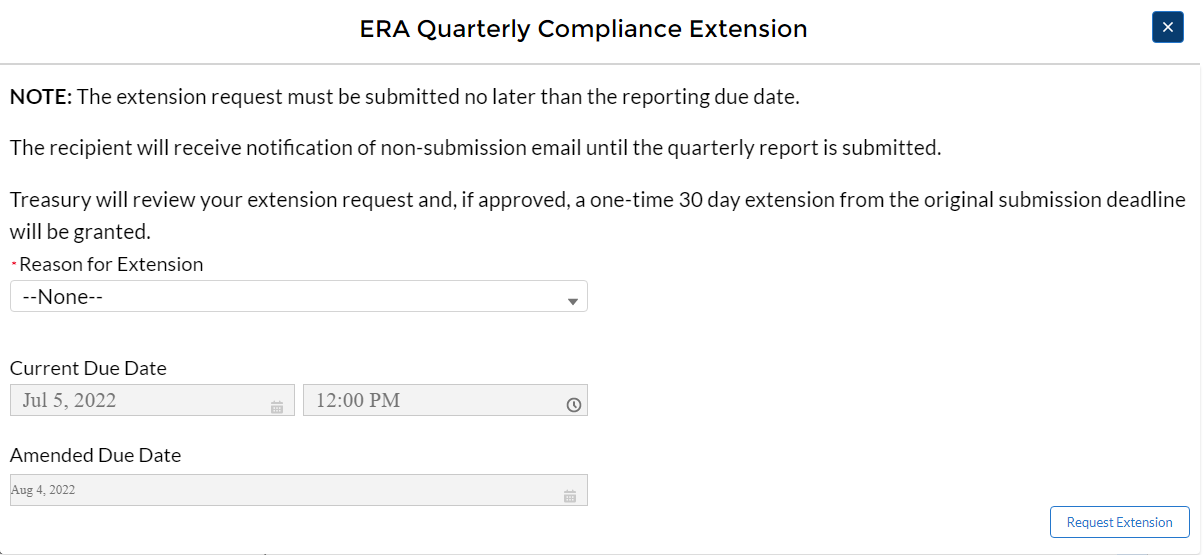
Figure 17 – Reason for Extension
The portal has two information tabs. These are the Reporting Guidance and the Bulk Upload Templates and Instructions tab. These tabs provide hyperlinks to the ERA2 Reporting Guidance, User Guide, bulk upload templates, and other information on completing the ERA2 Quarterly Reports.
The Bulk Upload Templates and Instructions Tab provides hyperlinks to the bulk upload templates. The bulk upload templates are revised frequently. The latest revision date is listed next to the template name as shown below. Please verify that the revision date shown on the upper left corner (Cell A1) on each downloaded template matches the date listed for the file in the Bulk Upload tab. Please ensure that you are always using the latest version of each template prior to starting your quarterly report submissions.
ERA2 Recipients must review and confirm pre-populated information about the entity’s SAM.gov registration status and executive compensation. Refer to the ERA2 Reporting Guidance for additional details about the required information.
The Recipient Profile tab has two segments: a) Recipient
Profile and b) SAM.gov Registration and Executive Compensation.
Recipient Profile will be pre-populated with information from the Recipient’s ERA2 application and other sources (see Figure 18).
The screen will also display the names and contact information for individuals the ERA2 Recipient has designated for key roles for ERA2 program reporting.

Figure 18 – ERA Recipient Information
Please use the textbox “Please Report any Errors or Needed Updates (if any)” (see Figure 19) to flag errors, notifying Treasury of information that needs to be corrected.

Figure
19 – Report Errors and Updates
Please use the dropdown (see Figure 20) to confirm your entity’s SAM.gov status and Executive Compensation reporting eligibility questions.
Note: This information is required for Treasury to complete the FSRS.gov reporting on your behalf.
![]()
If the ERA2 Recipient is registered in SAM.gov, select “Yes” from the picklist (see Figure 21) and move on to Step 7 below.
![]()
Figure 21 – SAM.gov Registration
If the ERA2 Recipient is not registered in SAM.gov, select “No” from the picklist. Two additional questions will populate the space below (see Figure 22).

Figure 22 – Additional Questions
Note: For SAM.gov registration assistance, please contact the Federal Service Desk at www.fsd.gov or 1-866-606-8220.
If the ERA2 Recipient received 80% or more of its annual gross revenue from federal funds in the preceding fiscal year AND the ERA2 Recipient received $25 million or more of its annual gross revenue from federal funds, an additional question will appear (see Figure 23).

Figure 23 – Annual Gross Revenue
Select “Yes” if the total compensation for the ERA2 Recipient organization’s five highest paid officers is publicly displayed or otherwise listed in SAM.gov (see Figure 24) and move on to Step 7 below.
![]()
Select “No” if the total compensation for the ERA2 Recipient organization’s five highest paid officers is not publicly displayed or otherwise listed in SAM.gov. Enter the name(s) of the officer(s) in the data entry table that will be displayed on-screen (see Figure 25), and the total compensation received by each. If fewer than five (5) officers exist, enter “N/A” and $0 in the empty field(s).
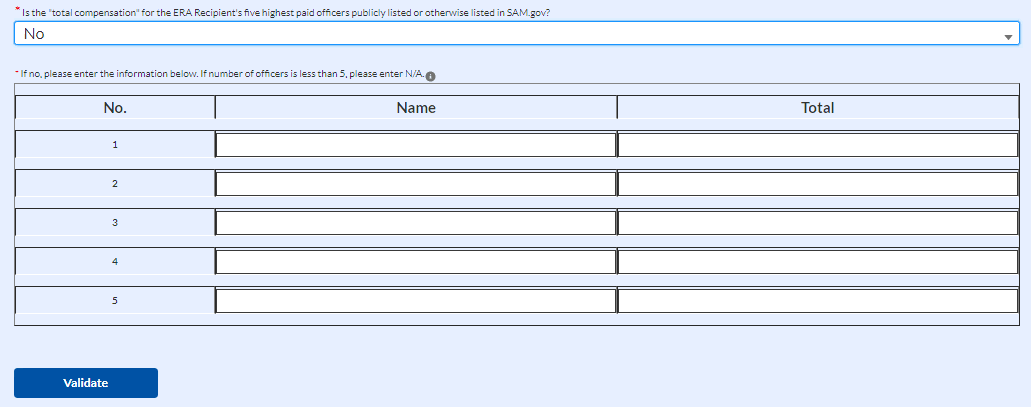
Figure 26 illustrates the table that will list the members of your organization that are currently designated for roles in managing the ERA2 Reports. Please review the list for accuracy. You can update this information by clicking the blue “here” icon above the table. Clicking the icon will open a tab where you can modify/update your organization’s staff and role designations. Please see the Hints and Tips for Designating Points of Contact for ERA1 and ERA2 Reporting for further details.

Figure 26 – ERA2 Reporting Contacts
Click the Save button to record progress.
![]()
Click the Next button to advance to the Project Overview tab.
![]()

Unique Entity Identifier (UEI)
ERA2 Recipients must provide the Unique Entity Identifier (UEI) for itself and for each of its Subrecipients and each of its Contractors that receive ERA2 obligations of $30,000 or more, and well as UEI or TINs for incorporated beneficiaries such as corporate landlords and utility providers that receive ERA2 obligations of $30,000 or more.
How to find the ERA2 Recipient’s UEI in the Portal
If the ERA2 Recipient entity is registered in SAM.gov, Treasury will retrieve its UEI from the Recipient’s existing SAM.gov profile. The Recipient profile will be updated automatically with the UEI (See Figure 27).
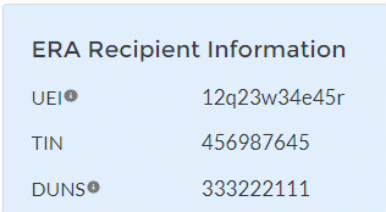
Figure 27 – UEI Information on Recipient Profile tab
The portal will also identify and pre-populate UEI numbers for the ERA2 Recipient’s subrecipient or contractor entities that maintain an active SAM.gov registration (See Figure 28).


Figure 28 – UEI Information on Subawards, Contracts and Direct Payments tab
How to find UEI on SAM.gov
If a ERA2 Recipient is registered in SAM.gov, its Unique Entity ID (SAM) has been assigned and is viewable in SAM.gov. This includes inactive registrations. The Unique Entity ID is currently displayed below the DUNS Number on your entity registration record. Remember, you must be signed in to your SAM.gov account to view the entity records. To learn how to view your Unique Entity ID (SAM) go to this help article.
On the ERA2 Project Overview tab, ERA2 Recipients report on up to three categories of ERA2 projects associated with their ERA2 award.
Note: Beginning on October 1, 2022, ERA2 Recipients that have obligated at least 75 percent of their total ERA2 allocation for emergency rental assistance and related activities may use the unobligated amounts of their ERA2 allocation to support one or more of three categories of ERA2 projects. See FAQ 46 for more information. The three types of allowed ERA2 projects are: ERA2 Emergency Rental Assistance Project; ERA2 Affordable Rental Housing Project; and ERA2 Eviction Prevention Project.
All ERA2 Recipients will use this tab to report on their ERA2 Emergency Rental Assistance projects.
ERA2 Recipients that are using ERA2 funds for one or more ERA2 Affordable Rental Housing and/or ERA2 Eviction Prevention project(s) will also use this tab to report on those categories of projects.
All data required on the Project Overview tab must be inputted manually. Bulk Upload templates are not available for these sections of the quarterly reports.
The core section displayed on the Project Overview tab is the My Projects Dashboard screen as shown (see Figure29). As shown, each of the recipient’s ERA2 project(s) has three buttons/check boxes for “Project Status”, “Obligation Status”, and “Expenditure Status.” Prior to report submission, all check boxes must display a Green Checkmark. Click on the buttons to make updates or to see items requiring corrections.
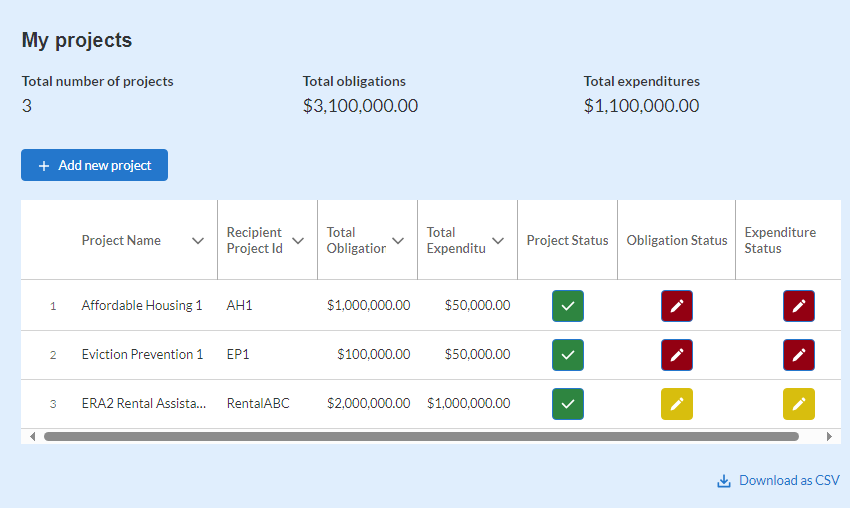
Figure 29 – My Project Dashboard
The My Project dashboard displays information about the ERA2 Recipient’s ERA2 Emergency Rental Assistance Project. The dashboard is programmed to be prepopulated with information about the rental assistance project on each ERA2 Recipient’s dashboard.
If the ERA2 Recipient also administers an ERA2 Affordable Rental Housing Project(s) and/or an ERA2 Eviction Prevention Project(s), the Recipient must input information about those projects into the dashboard as part of their quarterly reports. See below for detailed instructions on entering the required information about each of the Recipient’s ERA2 projects. Figure 34 shows a sample dashboard for an ERA2 Recipient with three projects – that is, the Emergency Rental Assistance Project, one Affordable Rental Housing Project, and one Eviction Prevention Project.
As shown in Figure 29, the dashboard displays the following items.
Number of Projects. This number is calculated by the portal based on the information the ERA2 Recipient enters on the My Project data entry screen. The number of projects is displayed on-screen. In Figure 29, the number “3” is displayed because the sample ERA2 Recipient is administering the three projects listed above.
Total Obligations. This is the sum of amounts inputted on this tab by the ERA2 Recipient as being the cumulative amounts obligated as of the end of the reporting period for each of its three projects. As shown on Figure 29, the sample ERA2 Recipient has reported cumulative obligations of the following amounts: $1,000,000 for its Affordable Rental Housing Project; $100,000 for its Eviction Prevention Project; and $2,000,000 for its Emergency Rental Assistance Project. The dashboard displays the sum of the obligated amounts under the heading “Total Obligations”, that is $3,100,000.
Total Expenditures. This is the sum of expenditure amounts inputted on this tab by the ERA2 Recipient for the ERA2 Emergency Rental Assistance project plus amounts expended under the Affordable Rental Housing project and the Eviction Prevention Project. As shown on Figure 30, the sample ERA2 Recipient has reported cumulative expenditures in the following amounts: $50,000 for its Affordable Rental Housing Project; $50,000 for its Eviction Prevention Project; and $1,000,000 for its Emergency Rental Assistance Project. The dashboard displays the sum of the obligated amounts under the heading “Total Expenditures,” that is $1,100,000.
The dashboard screen also displays the following information about each ERA2 Recipient’s projects. All the displayed information is manually entered by the ERA2 Recipient on the dashboard pop-up pages (see below for input details):
Project Name. This is the name for the specific project as inputted by the ERA2 Recipient. The sample ERA2 Recipient has three separate projects so the Recipient inputted three different names. That is, a different name for each project.
Recipient Project ID. This a string of figures inputted by the ERA2 Recipient that will serve as the ID for the given ERA2 Project. The ERA2 Recipient is administering three separate projects, so it inputted different Project IDs for each of the three projects.
Total Obligations. This is the cumulative amount obligated for the project as entered by the ERA2 Recipient. The ERA2 Recipient manually inputs this amount on the pop-up screens for each project.
Total Expenditures. This is the cumulative amount expended for the project as entered by the ERA2 Recipient. The ERA2 Recipient manually inputted this amount on the pop-up screen. Note that the dashboard displays red and yellow check marks, which indicate that the information the ERA2 Recipient entered on the pop-up screen does not align with what was entered on the portal’s Expenditures and/or Subaward tabs.
Project Status. The dashboard displays on Project Status check mark for each of the sample ERA2 Recipient’s three projects. A green checkmark indicates the inputted data about the specific project appears valid. A yellow checkmark indicates that something about the inputted information about the specific is not correct or is invalid.
Obligation Status. The dashboard also verifies the obligation information inputted by the ERA2 Recipient about each of its projects. A green checkmark in this location for a specific project indicates that cumulative obligation amount entered in the My Project screen for total obligations for the specific project aligns with the amounts of obligations recorded for the project on the Subaward, Contractor and Beneficiaries Tab and the Expenditures Tab. A yellow or red checkmark indicates that the cumulative obligation amount entered by the ERA2 Recipient on the pop-up window is inconsistent with data the ERA2 Recipient entered on the portal’s Subaward and Expenditures tabs.
Expenditures Status. Like the Obligation Status, this is also a green, yellow, or red checkmark. Green indicates the cumulative expenditure as entered on the My Project screen for the specific project aligns with the sum of expenditures recorded for the project on the Expenditures tab. A yellow or red checkmark indicates that the cumulative expenditure amount entered by the ERA2 Recipient on the pop-up window is inconsistent with data the ERA2 Recipient entered on the portal’s expenditures tabs.
Required Data -- Recipient’s ERA2 Emergency Rental Assistance Project
All ERA2 Recipients are administering one ERA2 Emergency Rental
Assistance Project which will be highlighted on the Project Overview
Dashboard as shown by the red-outlined information shown. (See Figure
30.)


Figure 30 – Additional Features of the My Projects Dashboard
Each ERA2 Recipient must provide the following information about their ERA2 Emergency Rental Assistance Project via a pop-up window the Project Overview Tab. To access the pop-up window, press the Green Check box in the “Project Status” column on the dashboard, as shown. (See Figure 31.)


Figure 31 – Project Status Button
When the user clicks on the Project Status check box on the
ERA2 Rental Assistance Project area of the dashboard, the “Edit
Project” pop-up window will be displayed on-screen.
The Edit Project contains 15 required data fields about the status of the ERA2 Emergency Rental Assistance Project as shown below.
ERA2 Recipients must manually enter the following data on its ERA2 Emergency Rental Assistance project on the pop-up screen.
ERA Project Category. “Rental Assistance” will be pre-populated for the Rental Assistance project in the drop-down for this data field as shown. (See Figure 32.)

Figure 32 – ERA Project Category
Project Name. Input or Edit the name of the ERA2 Emergency Rental Assistance Project in the data field as shown. Please make certain the name provided is different from project names entered for other ERA projects. (See Figure 33.)
![]()
Figure 33 – Enter Project
Name
Recipient Project ID. Input the Project ID developed by the ERA2 Recipient in the data field as shown in Figure 34. Please make certain the Project ID provided for the Recipient’s ERA2 emergency Rental Assistance Project is different from Project IDs created for any other of the Recipient’s projects and is also different from the Recipient’s ERA1 Project ID.

Figure 34 – Enter Project ID
Total Cumulative Obligations for this Project. Enter the total cumulative dollar value of obligations made by the Recipient under this ERA2 Emergency Rental Assistance project from the initiation of the project through the end of the current reporting period. Enter the cumulative amount in the field as shown in Figure 35.

Figure 35 – Enter Cumulative Obligations
Total Cumulative Expenditures for this Project. Enter the total cumulative dollar value of expenditures for this ERA2 Emergency Rental Assistance project from the initiation of the project through the end of the current reporting period. Enter the cumulative amount in the field as shown in Figure 36.

Figure 36 – Enter Cumulative Expenditures
Current Period Obligations for this Project. Enter the
obligations by the ERA2 Recipient made in the current reporting
period for this ERA2 emergency rental assistance project in Figure
37.

Figure 37 – Enter Current Period Obligations
Current Period Expenditures for this Project. Enter the expenditures the ERA2 Recipient and its subrecipients made in the current reporting period for this ERA2 emergency rental assistance project in Figure 38.

Figure 38 – Enter Current Project Expenditures
Status to Completion. Select from the drop-down list to identify the ERA2 Recipient’s estimate of the status of this ERA2 Emergency Rental Assistance Project. The selection options are: Not Started; Completed Less than 50%: Completed 50% or More; Completed; Cancelled, as shown in Figure 39.

Figure
39 – Status to Completion
ERA Project Website URL. Provide the URL for this ERA2 Emergency Rental Assistance website that is used to educate the public about the project. Enter the URL in the field as shown in Figure 40.
![]()
Figure 40 – Project Website
Geographic Service Area. Select from the dropdown list to
identify the geographic service area covered by this ERA2 Emergency
Rental Assistance project. The selection options are:
State-wide;
County-wide; City-Wide; Targeted Communities, as shown in Figure 41.

![]()
Figure 41 – Service Area
ERA2 Emergency Rental Assistance Project Description. Provide a narrative (12,000 characters (2,000 word) or less) with the following information about this ERA2 Emergency Rental Assistance Project as of the end of the reporting period, as applicable:
Performance goals planned and met.
Major timelines.
Key partner organizations.
Planned outreach strategies.
Other housing services provided.
Housing stability services provided; and
Other affordable rental housing and eviction prevention services provided, if applicable. Do not include information on any affordable rental housing or eviction prevention services provided as authorized in FAQ46.
Provide the narrative (or update the narrative reported in past quarters) in the text box provided. The text box can be resized as needed. See Figure 42.
![]()
Figure 42 – Text Box for Narrative
Narrative on Approach for Prioritizing ERA2 Assistance to Certain Households. Review and update, as needed, the previously submitted description (as submitted on prior quarterly reports) of the ERA2 Recipient’s approach for prioritizing ERA2 assistance to certain households (e.g., households with incomes less than 50% of area median income and those with at least one member who were unemployed 90 days or more prior to the date the household applied for ERA2 assistance), and provide a URL where the information on the system for prioritizing the assistance is publicly available. See Figure 43.
![]()
Figure 43 – Text Box for Narrative
Use of a Fact-Based Proxy for Determining Eligibility. Select from a dropdown list to indicate whether the ERA2 Recipient used a fact-based proxy for determining applicants’ income eligibility for financial assistance under this ERA2 Emergency Rental Assistance Project. The selection options are: Yes and No, as Shown in Figure 44.

![]()
Figure 44 – Select Yes or No
If the ERA2 Recipient selects “yes” on the dropdown list the portal will display a follow-up text box where the ERA2 Recipient must provide a narrative (12,000 characters (2,000 words, or less)) describing the proxy and all relevant thresholds, figures, policies, and procedures used for verifying eligibility. The ERA2 Recipient should type or cut and paste the narrative in the text box provided. The text box will display the narrative submitted in the most recent quarterly report and the Recipient can provide edits and updates as needed. The ERA2 Recipient may choose to submit an entirely new narrative as well. Provide the information in the text box as shown in Figure 45.
![]()
Figure 45 – Text Box for Narrative
When the user has provided all required information on the screen, click the “Save Project” button at the bottom left of the screen.
![]()
Required Data -- ERA2 Affordable Rental Housing Project(s)
All ERA2 Recipients that have initiated an ERA2 Affordable Rental Housing Project must create a record for that project on the Project Overview tab.
The Recipient must set-up separate reporting records for each ERA2 Affordable Rental Housing Project it initiates. Each ERA2 Affordable Rental Housing development funded in whole or in part with ERA2 funds is a separate project, and as such, grantees that use ERA2 funds to support multiple such housing developments will report each of them as a separate ERA2 Affordable Housing Development Project.
To set up a new ERA2 Affordable Housing Development Project reporting record, the user must click the “Add Project” button on the top left section of the My Projects Dashboard as shown in Figure 46.

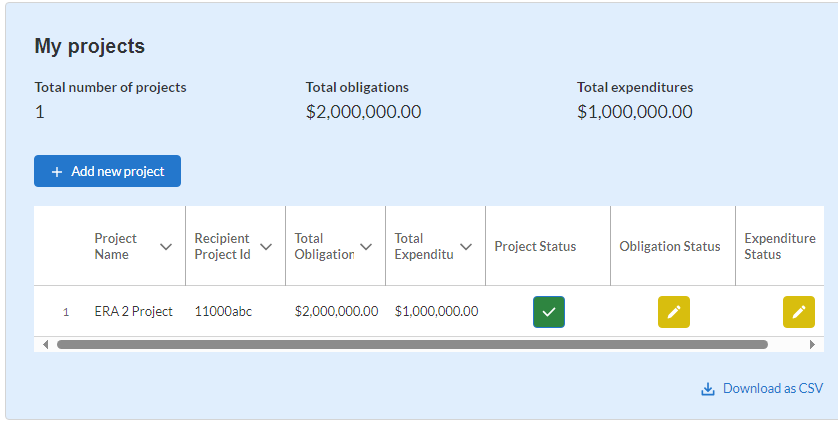
Figure 46 – Add Project Button
Clicking on the “Add Project” button will display the “Add Project” pop-up screen as shown in Figure 47.
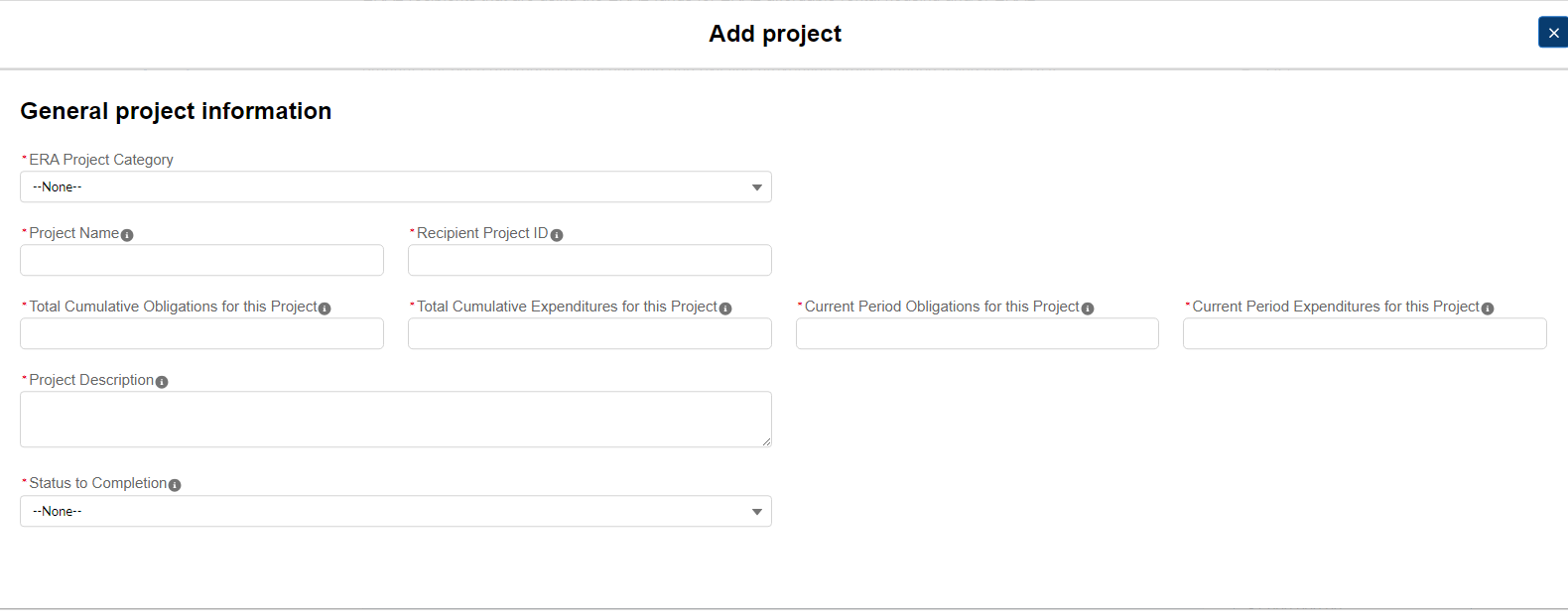
Figure 47 – Add Project Pop-Up Screen
The field at the top of the “Add Project” pop-up screen is the “ERA Project Category” field, which is a dropdown list. Users should select “Affordable Housing” from the dropdown list as shown on Figure 48.
![]()
Figure 48 – Project Category
When Affordable Housing is selected under “ERA Project Category”, the Project Pop-Up will display 32 required data fields describing the ERA2 Affordable Rental Housing Project as shown below.
ERA2 Recipients must provide the following information about their ERA2 Affordable Rental Housing Project(s)
Project Name. Input the name of the ERA2 Emergency Rental Assistance Project in the data field as shown on Figure 49

Figure
49 – Project Name
Recipient Project ID. Input the Project ID developed by the ERA2 Recipient in the data field as shown in Figure 50. Please make certain the Project ID for the Recipient’s ERA2 Emergency Rental Assistance Project is different from the ID used for other ERA2 and ERA1 projects.

Figure 50 – Project ID
Total Cumulative Obligations for this Project. Enter the total dollar value of obligations made by the Recipient under this ERA2 Affordable Rental Housing project from the initiation of the project through the end of the current reporting period as shown in Figure 51.

Figure 51 – Cumulative Obligations
Total Cumulative Expenditures for this Project. Enter the total dollar value of expenditures for this ERA2 Affordable Rental Housing project from the initiation of the project through the end of the current reporting period as shown in Figure 52.

Figure 52 – Cumulative Expenditures
Current Period Obligations for this Project. Enter the obligations the ERA2 Recipient made in the current reporting period for this ERA2 Affordable Rental Housing project as shown in Figure 53.

Figure 53 – Current Period Obligations
Current Period Expenditures for this Project. Enter the expenditures the ERA2 Recipient and its subrecipients made in the current reporting period for this ERA2 Affordable Rental Housing project as shown in Figure 54.

Figure 54 – Current Period Expenditures
Project Description. Users must provide a brief narrative description of the project (minimum of 300 and maximum of 500 words). Please describe how this funding fulfills a specific need within the community supports “affordable rental housing purposes” as specified in FAQ46 and integrates with other program resources and/or funds to provide services, and so forth. See Figure 55.

Figure 55 – Project Description
Status
to Completion. Select from the drop-down list to identify the
ERA2 Recipient’s estimate of the status of this ERA2 Affordable
Rental Housing Project. The selection options are: Not Started;
Completed Less than 50%: Completed 50% or More; Completed; Cancelled,
as shown in Figure 56.
Figure 56 – Status to Completion
Obligations and Expenditures Through Q4 2022. Users are asked to report the cumulative amount of ERA2 funds the ERA2 Recipient had obligated and expended for this ERA2 Affordable Rental Housing project as of the end of Quarter 4 2022. Please enter “0” is no funds had been obligated / expended by that time. Once this data is entered on a quarterly report it will carry forward and appear on future quarterly reports. See Figure 57.

Figure 57 – Obligations and Expenditures through Q4 2022
Project Zip code. Please input the zip code for the physical location of the housing development project that comprises this ERA2 Affordable Rental Housing Project, as shown in Figure 58.

Figure 58 – Project Zip Code
Project Address. Please input the physical address of the housing development that comprises this ERA2 Affordable Rental Housing Project, as shown on Figure 59.


Figure 59 – Project Address
Select
a Primary Use of Funds. The uses of ERA2 funds for this ERA2
Affordable Rental Housing Project must align with allowed uses of
Federal funds under at least one of the Federal programs listed on
the dropdown list for this question. Users must identity the primary
Federal program from the dropdown list. See Figure 60. The options
are:
Low-Income Housing Tax Credit (Treasury);
HOME
Investment Partnerships Program (U.S. Department of Housing and Urban
Development (HUD))
HOME-ARP Program (HUD)
Housing Trust
Fund Program (HUD)
Public Housing Capital Fund (HUD)
Indian
Housing Block Grant Program (HUD)
Section 202 Supportive
Housing for the Elderly (HUD)
Section 811 Supportive Housing
for Persons with Disabilities (HUD)
Farm Labor Housing Direct
Loans and Grants (U.S. Department of Agriculture (USDA)) Multifamily
Preservation and Revitalization Program (USDA
 Figure
60 – Use of Funds Aligned with Federal Program
Figure
60 – Use of Funds Aligned with Federal Program
Is the grantee complying with the program regulations and other requirements of the federal program(s) noted above? Users must indicate whether the ERA2 grantee is in full compliance with the regulations and other requirements of the Federal program with which the ERA2 funds are aligned (as noted in the question above). Users must select from the dropdown list. The selection options are: Yes and No. See Figure 61.


Figure 61 – Compliance with Program Regulations
Besides ERA2, other Federal Program Funds Used for this Project. Users must select one or more additional Federal program(s), if any, used together with the ERA2 funds for this ERA2 Affordable Rental Housing Project. Users should select one or more of the federal programs listed in the “Available” box and move them into the “Chosen” box on-screen as shown in Figure 62.

Figure 62 – Other Federal Fund
Estimate Total Development Cost. Users must provide the total estimated cost of the affordable rental housing project (dollar amount). ERA2 Recipients should update this estimate each reporting period to account for changes in cost projections. See Figure 63.
![]()
Figure 63 – Estimated Total Development Cost
Estimated portion of total development cost of the ERA2 Affordable Rental Housing project attributable to affordable rental housing. Users must provide the overall estimated cost of this project to be used for affordable rental housing. ERA2 Recipients should update this estimate each reporting period to account for changes in cost projections. See Figure 64.
![]()
Figure 64 – Portion Attributable to Affordable Rental Housing
Units serving very low-income families. Users must provide the number of units in this affordable rental housing project designated for very low-income families. The term “Low-income families” is defined as families whose incomes do not exceed 50 percent of the median area family income. See Figure 65.
![]()
Figure 65 – Units Designated for Very Low-Income Families
Estimated start of service of the project. Users must use the calendar feature displayed on the screen to identify the estimated start of service date for this ERA2 Affordable Rental Housing project. See the regulations for the Federal program with which the uses of ERA2 funds are aligned to determine what constitutes the “start of service.” For projects that predated the ERA2 Recipient’s contribution of ERA2 funds, please note the start of service for the specific ERA2-funded units. See Figure 66.
![]()
Figure 66 – Estimated Project Start Date
Date of first ERA2 expenditure on project. Users must use the calendar feature displayed on the screen to identify the date the ERA2 Recipient’s first expenditure of ERA2 funds for this ERA2 Affordable Rental Housing Project. Please use the definition of expenditure for the Federal program with which the uses of ERA2 funds are aligned to determine this date. If the program does not specify, the ERA2 Recipient should use its internal accounting mechanisms to determine its first expenditure. See Figure 67
![]()
Figure 67 – Date of First ERA2 Expenditure
Sources and Amounts of Non-ERA2 Funding for Project. Users must provide the name(s) of all sources of non-ERA2 funds used for this affordable rental housing project and the amount(s) provided by each source. Sources of funds may include, for example, the ERA2 Recipient’s own budget; funds provided through other federal, state, or local housing programs; funds provided through nongovernmental entities; and private investments. ERA2 Recipients should update this estimate each reporting period to account for changes. The portal displays 10 pairs of “Source” and “Amount” fields. The “Source” text box can be enlarged to accommodate several sentences if needed. Figures xxx below shows an example of one pair. See Figure 68.

Figure 68 – Non-ERA2 Funding
Funding Mechanism Used. Recipients must list the financial instrument used to fund the affordable rental housing with ERA2 funds. Users must identify one or more financial instrument(s) that has been or will be used for this ERA2 Affordable Rental Housing project. Select from the dropdown list. The selection options are Loans [including no-interest loans and deferred-payment loans]; Interest Subsidies; Grants; Other financial arrangements. See Figure 69.


Figure 69 – Funding Mechanism
Whether the ERA2 funds are used as gap funding for an existing project. Users must indicate whether the ERA2 funds are being / will be used as gap funding for an affordable rental housing project that was in existence prior to October 2022. Select from the dropdown list. The selection options are: Yes; No. See Figure 70.


Figure 70 – Gap Funding
Type of project. The ERA2 Recipient must select the category that most accurately describes the predominant objective of the affordable rental housing project. Users must select the category that most accurately describes the predominant objective of this affordable rental housing project from the dropdown list. If the user selects, “other” please provide a brief explanation. The selection options are Rehabilitation; Construction; Preservation; Operation; Other. See Figure 71.


Figure 71 – Project Type
Total number of rental units in project. The user most provide the total number of rental units planned for this ERA2 Affordable Rental Housing project. ERA2 Recipients should update this estimate each reporting period to account for changes. See Figure 72.

Figure 72 – Number of Rental Units to Total
Number of rental units funded by ERA2. Users must provide the total number of rental units planned to be supported with ERA2 funds as part of this affordable rental housing project. ERA2 Recipients should update this estimate each reporting period to account for changes. See Figure 73.

Figure 73 – Number of Rental Units funded with ERA2 Funds
Description of income limitation on rental units funded by ERA2. Users must provide a brief narrative description of current income requirements for tenants of the ERA2-funded rental units in this ERA2 Affordable Rental Housing project as of the end of the reporting period. ERA2 Recipients should update the response in subsequent reporting periods as needed. The text box can be enlarged to accommodate several sentences if needed. See Figure 74.

Figure 74 – Description of Income Limitation
Description of income restrictions on non-ERA2 funded rental units. Users must provide a brief narrative description of current income requirements for tenants of the non-ERA2-funded rental units (if any) in this affordable rental housing project as of the end of the reporting period. ERA2 Recipients should update the response in subsequent reporting periods as needed. The text box can be enlarged to accommodate several sentences if needed. See Figure 75.

Figure 75 -- Narrative
Development Partners (if any). Users must provide the names of all entities that are/ will be collaborating with the ERA2 Recipient on this affordable rental housing project as of the end of the reporting period. The text box can be enlarged to accommodate several sentences if needed. See Figure 76.

Figure 76 – Development Partners
Are programs limited to specific populations (e.g., elderly, domestic violence survivors, etc.)? If this affordable rental housing project is limited to specific tenant populations, please list the specific populations as of the end of the reporting period. See Figure 77.

Figure 77 – Specific Populations
Period of legally enforceable income limitations for ERA2-funded rental units. Users must provide the duration (in years and months, such as “10 years and 6 months” or “5 years”) of the income requirements/limitations for tenants of ERA2-funded rental units in this affordable rental housing project. See Figure 78.

Figure 78 – Period of Legally Enforceable Income Limitations
Period of legally enforceable income limitations for any non-ERA2 funded rental units. Users must provide the duration (in years and months, such as “10 years and 6 months” or “5 years”) of the income requirements/limitations for tenants of ERA2-funded rental units in this affordable rental housing project. See Figure 79.
![]()
Figure 79 – Period of Legally Enforceable Income Limitation, Non-ERA2 Funded Units
When the user has provided all required information on the screen, they should click the “Add Project” button.
![]()
Required Data -- Recipient’s ERA2 Eviction Prevention Project(s)
All ERA2 Recipients that initiate an ERA2 Eviction Prevention Project must create a record for that project on the Project Overview tab. The Recipient must create separate records for each ERA2 Eviction Prevention Project it initiates.
To set up a new ERA2 Eviction Prevention Project, the user must click the “Add Project” button on the top left section of the My Projects Dashboard as shown in Figure 80.


Figure 80 – Add New Project Button
Clicking on the “Add Project” button will display the “Add Project” pop-up screen as shown in Figure 81.

Figure 81 – Add Project
The field at the top of the “Add Project” pop-up screen is the “ERA Project Category” field, which is a dropdown list. Users should select “Eviction Prevention” from the dropdown list as shown on Figure 82

Figure 82 – ERA Project Category
When the “Eviction Prevention” is selected, the Edit Project Pop-Up will display a series of 17 required data fields about the status of the ERA2 Eviction Prevention Project as shown below.
ERA2 Recipients must provide the following information about their ERA2 Eviction Prevention Project(s).
Project Name. Input the name of the ERA2 Eviction Prevention Project in the data field as shown on Figure 83.

Figure 83 – Project
Name
Recipient Project ID. Input the Project ID developed by the ERA2 Recipient in the data field as shown in Figure 84. Please make certain the Project ID for the Recipient’s ERA2 Eviction Prevention Project is unique to the specific project (different from other ERA1 & ERA2 project IDs).

Figure 84 – Recipient Project ID
Total Cumulative Obligations for this Project. Enter the total dollar value of obligations made by the Recipient under this ERA2 Eviction Prevention Project from the initiation of the project through the end of the current reporting period as shown in Figure 85.

Figure 85 – Total Cumulative Obligations
Total Cumulative Expenditures for this Project. Enter the total dollar value of expenditures for this ERA2 Eviction Prevention Project from the initiation of the project through the end of the current reporting period as shown in Figure 86.

Figure 86 – Total Cumulative Expenditures
Current Period Obligations for this Project. Enter the obligations the ERA2 Recipient made in the current reporting period for this ERA2 Eviction Prevention Project as shown in Figure 87.

Figure 87 – Current Period Obligations
Current Period Expenditures for this Project. Enter the expenditures ERA2 Recipient and its subrecipients made in the current reporting period for this ERA2 Eviction Prevention Project as shown in Figure 88.

Figure 88 – Current Period Expenditures
Project Description. Provide a brief narrative description of this ERA2 Eviction Prevention project (minimum of 300 words and maximum of 500 words). Please describe how this funding fulfills a specific need within the community, supports broader eviction prevention and housing stability initiatives as specified in FAQ46, integrates with other program resources and/or funds to provide services, and so forth. The text box can be enlarged to accommodate several sentences if needed. See Figure 89.

Figure 89 – Project Description
Status
to Completion. Select the most accurate status descriptor for
this ERA2 eviction prevention project. The options are: Not Started,
Completed Less than 50%; Completed 50% or More; Completed; Cancelled.
See Figure 90.

Figure 90 – Status to Completion
Obligations and Expenditures Through Q4 2022. Users are asked to report the cumulative amount of ERA2 funds the ERA2 Recipient had obligated and expended for this ERA2 Eviction Prevention Project. Please enter “0” is no funds had been obligated / expended by that time. Once this data is entered on a quarterly report it will carry forward and appear on future quarterly reports. See Figure 91.

Figure 91 – Obligations and Expenditures Through Q4 2022
Is this ERA2 Evection Project an existing prevention program previously funded under the housing stability services provision of ERA2? Select from the dropdown list. The selection options are: Yes and No. See Figure 92.

Figure 92 – Existing Eviction Prevention Program
Number of unique households that received their initial Eviction Prevention Services under this project during the current reporting period. Please enter the total number of unique households that received their first eviction prevention services under this ERA2 Eviction Prevention Project in the current reporting period. In determining the total number of unique households receiving this assistance, count any household only one time, even if the household received the services more than once in the reporting period. See Figure 93.

Figure 93 – Households Receiving Initial Eviction Prevention Services
Number of unique households that received Eviction Prevention Services under this project cumulatively from award date through the end of the reporting period. Enter the cumulative number of households received any amount of eviction prevention services under this ERA2 project from the initiation of this project through the end oof the current reporting period. In determining the cumulative total, count any household only one time, even if the household received services more than once. See Figure 94.

Figure 94 – Households Received Eviction Prevention Services
Less than 30% of area median income. Enter the cumulative number of households that received any amount of eviction prevention services under this ERA2 project from the initiation of this project through the end of the current reporting period, with household incomes less than 30% of area median income. In determining the cumulative total, count any household only one time, even if the household received services more than once. See Figure 95.

Figure 95 – 30% AMI
Between 30 and 50% of area median income. Enter the cumulative number of households that received any amount of eviction prevention services under this ERA2 project from the initiation of this project through the end of the current reporting period, with household incomes between 30% and 50% of area median income. In determining the cumulative total, count any household only one time, even if the household received services more than once. See Figure 96.

Figure 96 – 30-50% AMI
Between 50 and 80% of area median income. Enter the cumulative number of households that received any amount of eviction prevention services under this ERA2 project from the initiation of this project through the end of the current reporting period, with household incomes between 50% and 80% of area median income. In determining the cumulative total, count any household only one time, even if the household received services more than once. See Figure 97.

Figure 97 – 50-80% AMI
Total amount of ERA funds for Eviction Prevention Services paid to or for participant households under this project. Enter the cumulative total amount of ERA2 funds the grantee and/or its subrecipients and contractors, as applicable, expended (paid) to participant households under this ERA2 eviction prevention project from the initiation of this project through the end of the current reporting period. See Figure 98.

Figure 98 – ERA2 Funds Paid for Eviction Prevention
When the user has provided all required information on the screen, click the “Save Project” button at the bottom left of the screen.
In this Tab, users report details about all entities (Subrecipients, Contractors and Beneficiaries (other than beneficiaries who are individual tenants or individual/small business landlords)) to which the ERA2 Recipient obligated $30,000 or more as of the end of the reporting period. Please refer to “Subrecipients, Contractors, and Beneficiaries Tab” in the ERA Reporting Guidance for additional information.
The tab consists of two segments: a) Subrecipient Information and b) My Subrecipients (Subaward, Contract and Direct Payment).
ERA2 recipients use the Subrecipients, Contractors and Beneficiaries tab to either manually input or bulk upload data on entities that were established for the first time in the current quarter as the Recipient’s subrecipients, contractors or beneficiaries. For bulk upload instructions specific to this submodule, see Appendix A – Bulk Upload Overview. Note, Recipients should not provide information on Subrecipients, Contractor or Beneficiaries for whom the information was provided in previous quarters.
Users can download bulk file Template #1 for use in submitting the required data via bulk file upload. When ready to submit the data in your bulk upload file, use the Upload complete Template #1 button (see Figure 99).

Figure 99 – Bulk Upload of Subrecipient, Contractor and Direct Payee Records
Note: When using the bulk file upload capability or manual entry, subrecipient, contractor or beneficiary profiles must be completed prior to beginning the data entry for the subawards, contracts or direct payments.
Users that manually input the records for the entities that initially became the ERA2 Recipient’s Subrecipient, Contractors or Beneficiary in the current quarter should follow the instructions below.
If the user is making a profile record for a new Subrecipient, Contractor or Beneficiary, enter the relevant information in each of the required fields (see Figure 100). All starred information is required. All Subrecipients and Contractors must include the entity’s UEI number. Beneficiary records must include either the UEI or TIN.
All new records entered must also provide the “Entity Type.” This is the role of the entity, such as Subrecipient, Contractor, or Beneficiary.
As the user enters information about each Subrecipient, Contractor and Beneficiary, the list at the bottom of the page will populate with key information for each record. Subrecipient, Contractor and Beneficiary information entered in past quarterly reports will carry over from quarter to quarter. Please do not create duplicate records.
When all Subrecipient, Contractor and Beneficiary profile record information is entered, the user should click the Next button to advance to the next module.

Figure 100 – Subrecipient, Contractor, Beneficiary Record






Figure 101 – Download My Subrecipients List
Update/Delete/Search/Download Subrecipients, Contractors, and Beneficiaries records.
Users can update a Subrecipient, Contractor or Beneficiary record when the portal is accessible in any reporting period. However, users can delete a record of this kind only in the reporting period when the record was initially created and must perform the deletion before certifying and submitting the quarterly report.
To revise a record at any time, including in the quarterly report
where it was initially created, users can identify the record from
the on-screen list of subrecipient records. Click the corresponding
“eye” button to open the pop-up window that displays the
record details, then edit any of the fields shown on screen. Once the
revisions have been made use the “Save Subrecipient”
button (see Figure 102) to update and save the revised data.
To
delete the entire record before submitting the quarterly report where
the record was initially created by using the “Delete
Subrecipient” button (see Figure 102).
Note the “Delete Subrecipient” button shown in Figure 102 is not available after the ERA2 Recipient submits the quarterly report in which the record was initially created.

Figure 102 – Subrecipient Record
Use the Subaward, Contracts, and Direct Payments tab to enter
required information about all ERA2 obligations valued at $30,000 or
more (in the form of subawards, contracts and direct payments)
created by the ERA2 Recipient in the quarterly reporting period.
By
entering the required details about any obligations made in the
quarterly reporting period, the information will be maintained in the
portal’s database and users will be able to review the details
and report associated expenditures in the current and future
quarterly reports.
Please refer to the ERA
Reporting Guidance for additional information on required
information about reporting details of obligations made in the form
of subawards, contracts and direct payments.
Subaward, Contract, and Direct Payment Information
ERA2 Recipients can use either manual entry or bulk upload to provide required information on this tab. For bulk upload instructions specific to this tab, see Appendix A – Bulk Upload Overview. Users can download the bulk template using the provided link in Treasury’s portal and use the upload button (see Figure 103).

Figure 103 – Bulk Upload of Subawards, Contracts, and Direct Payment Records
Users that choose to manually enter records, follow the instructions below.
Enter the following fields: Subaward, Contract or Direct Payment Number, Amount Obligated, Date, Type, Performance Start, Performance End, Place of Performance Address, City, State, Zip, Zip+4, and Country. Valid selections are listed in blue font below two data elements in Figure 104 below.

Figure 104 – Subaward, Contract and Direct Payment Record
Figure 105 – Description of Subaward, Contract or Direct Payment
Enter the UEI for the Subrecipient or Contractor or UEI or TIN for the Beneficiary in the Select Subrecipient, Contractor or Beneficiary Entity text box (see Figure 104) and click the search icon on the right. If a Subrecipient, Contractor or Beneficiary record already exists, this will connect it to your Subaward, Contract, or Direct Payment.
Use the open textbox to provide a brief description of the Subaward, Contract or Direct Payment’s underlying eligible use (see Figure 105).
Click Create Subaward, Contract or Direct Payment Record to establish the Subaward record. Repeat Steps 1 through 3 to create additional Subaward, Contract or Direct Payment records.
The list of Subawards, Contracts and Direct Payments will be displayed below the “My Subawards, Contracts and Direct Payments” title at the bottom of the page (see Figure 106).
When finished adding to your list, click the Next button to advance to the Expenditures tab.



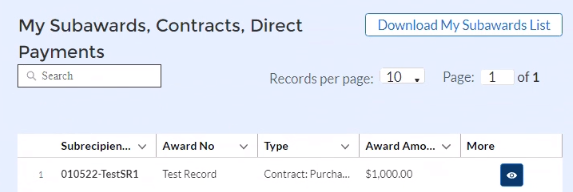
Update/Search/Download Subaward, Contract, and Direct Payment records
Please use the search box shown in Figure 106 to search for specific subrecipient, contractor or beneficiary records.
Users can use the “Download My Subawards List” button shown in Figure 106 to download as Excel file that lists your subrecipient, contractor and beneficiary records.
Users can then use the downloaded information to perform offline review and verification on the previously submitted information. Use this process to identify any records that require updates. Users can also use this process to download past and current quarter data for recordkeeping.
Alternatively, use the “eye” symbol in Figure 106 to view subaward, contract and direct payment records online. Figure 107 displays a view of the information that will be shown on-screen when clicking the “eye” symbol.

Figure 107 – Subaward, Contract, and Direct Payment Record
Update and Revise subaward, contract and direct payments records by editing any of the fields shown on the “Subaward” pop-up screen and using the “Save Subaward” button (see Figure 107). However, the “Grey” fields cannot be updated/changed. These include the ERA2 Project name, the Subaward Number; and the Treasury Subaward ID.
Note the “Delete Subrecipient” button shown in the figure above is not available after the ERA2 Recipient submits the quarterly report in which the record was initially created.
Subawards cannot be deleted completely after the quarterly report in which they were initially created has been certified and submitted, as noted above. Nevertheless, much information about a Subaward can be revised (including zeroing out ($0.00) the Subaward amount).
The “Narrative” box will appear only when a user edits a subaward record that was created in a previous quarter. Users should add notes under “Narrative” describing the changes made to the record before saving.
Section V. Expenditures Tab
ERA2 grantees must report all expenditures made in the reporting period as part of each quarterly report. Please refer to the ERA Reporting Guidance for additional clarification on the Expenditures tab.
Expenditures reporting is categorized into three groups:
(1) Expenditures Associated with the ERA2 Recipient’s Subawards, Contracts and Direct Payments for which it had obligated $30,000 or More.
(2) Total of all Obligations and Total of all Expenditures Associated with the ERA2 Recipient’s Subawards, Contracts and Direct Payments for which it has obligated Less than $30,000; and
(3) The ERA2 Recipient’s Obligations and Expenditures (Payments) to Individuals (Beneficiaries).
Like other tabs, the Expenditures reporting tab allows users to enter data manually or leverage the bulk file upload capability. For bulk upload instructions specific to this tab, see Appendix A – Bulk Upload Overview. Users can download the unique bulk templates for each of the three groups listed above using the provided link. (See Figure 108 for where to download and then upload Template #3.)

Figure 108 – Download and Upload Templates
Users that manually enter data should follow the steps below.
Expenditures Associated with the ERA Recipient’s Subawards, Contracts and Direct Payments Valued at $30,000 or More (see Figure 109).
Select the Treasury Subaward ID for the Subrecipient, Contractor, Direct Payee from the dropdown list. The number is in the “SUB-XXXX” format. Remember, the portal assigned the Treasury Subaward ID when you set-up records for the entity on the “Subrecipients, Contractors, and Beneficiaries” tab. Selecting the Treasury Subaward ID number will trigger the portal to populate several required fields on-screen.
Select the ERA2 Project Name from the dropdown list. Note, the default project is the ERA2 recipient’s Emergency Rental Assistance Project. If the recipient has established one or more ERA2 Affordable Rental Housing Project(s) or ERA2 Eviction Prevention Project(s) (the establishment of a project is accomplished on the Project Overview Tab), those projects will appear on the project drop-down list as well. Users should take care to associate each expenditure with the correct ERA2 Project.
To report new expenditures under a specific subaward, contract or direct payment, please enter the Recipient’s Subaward, Contract or Direct Payment Number in the search function under “Subaward ID” to associate the expenditure record to the appropriate subaward, contract or direct payment.
Enter the Expenditure Start Date, Expenditure End Date, and Expenditure Amount.
Select the associated ERA Expenditure Category from the drop-down picklist. There is a text box to provide a narrative with details on any Administrative Costs.
Cumulative Expenditures Amount Reported to Date is also shown on the screen (see Figure 110).
Click the Save Expenditure Records button at the lower left corner of the display to submit the expenditure record. Repeat Steps 1 through 5 to report additional expenditures. The submitted information will appear in an on-screen list immediately below the section. Proceed to the next segment once all expenditures are reported.
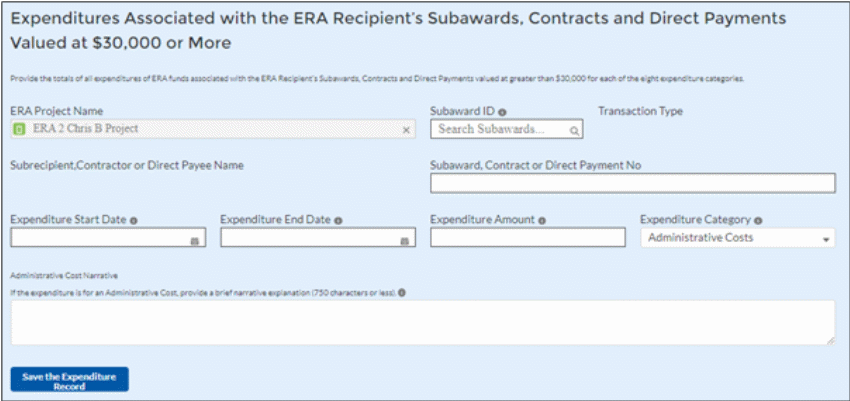
Figure 109 – Manual Input of Expenditures Associated with Obligations of $30,000 or More
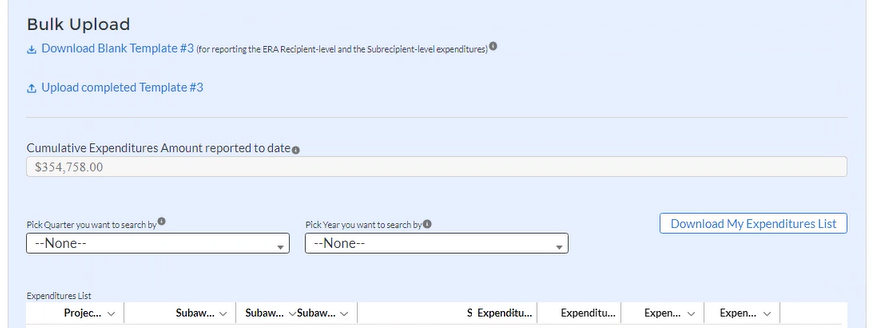
Figure 110 – Display of Cumulative Expenditure Amount Associated with Obligations of $30,000 or More
Note on Reporting Administrative Costs
ERA2 Recipients may create a “Subrecipient” or
“Contractor” record for itself to record and track
administrative expenses. To do so, the user should also create
“subaward” or “contract” records to obligate
ERA2 funds for administrative expenses, and report administrative
cost expenditures on the Expenditures Tab.
Alternatively, a user may use the default portal function that allows ERA2 Recipients to report any Administrative Costs incurred by the ERA2 Recipient (recipient-level) which are not associated with a subaward or contract for which the grantee had obligated less than $30,000.
To use this portal function to report an ERA Recipient’s administrative costs in amounts of $30,000 or more:
1. Leave the Subaward, Contract, Direct Payment ID/ number fields blank.
2. Enter the Expenditure Start Date, End Date, Expenditure Amount.
3. The Expenditures Category field is pre-selected to “Administrative Costs”.
5. Enter “N/A’ for the “Please provide a brief description” field.
6. Use the “Administrative Cost Narrative” field to provide a supporting narrative.
To report an ERA Recipient’s expenditure under a subaward or contract that is an administrative cost in an amount less than $30,000:
1. Select “Administrative Costs” for the Expenditures Category.
2. Use the “Administrative Cost Narrative” field to provide a supporting narrative.
Total Amount of Obligations and Expenditures Made in the Quarter Associated with the ERA2 Recipient’s Subawards, Contracts and Direct Payments for which the ERA2 Recipient had Obligated Less than $30,000 (see Figure 111).
Enter the Total Amount of Obligations and Expenditures in the Quarter . Users may enter “0” (zero) where appropriate.
Select the associated Expenditure Category and Subaward. Contract or Direct Payment Type from the drop-down picklist.
Click the Save Data Entry button to submit the record. Depending on the obligations and expenditures in the current reporting period, Steps 1 & 2 will need to be repeated up to 21 times (for 7 Expenditure Category types and 3 Aggregate Payment types).
Treasury’s portal will display an on-screen summary of the reported obligations and expenditures in tabular format. Please see Appendix B for a sample of the table. The sample may be particularly helpful for Recipients who manually key-in these data points.
Cumulative Obligations and Expenditures in this category from award date through the end of the reporting period will be displayed (based on the sum of all records reported in this section). These fields are automatically calculated and displayed in the middle of the subsection (see Figure112).
Proceed to the next segment of the Expenditures Tab once all obligations and expenditures made in the quarter are reported.
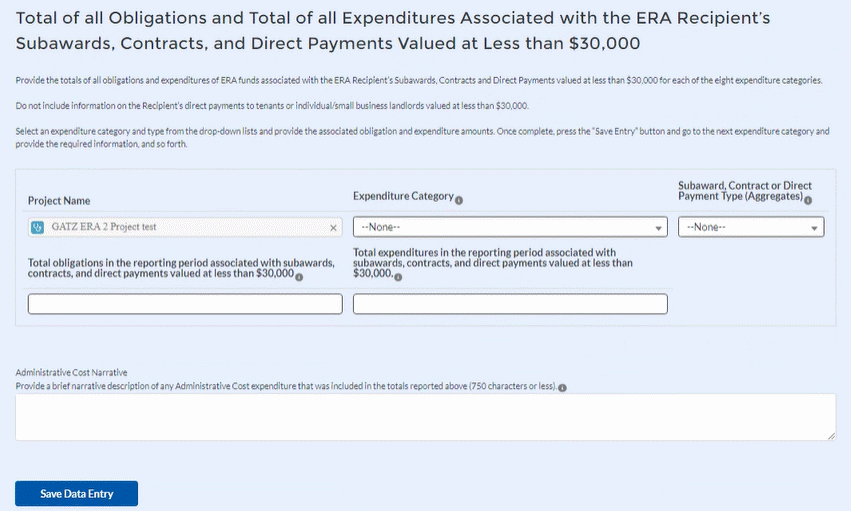
Figure 111 – Manual Input for Obligations and Expenditures of Less than $30,000
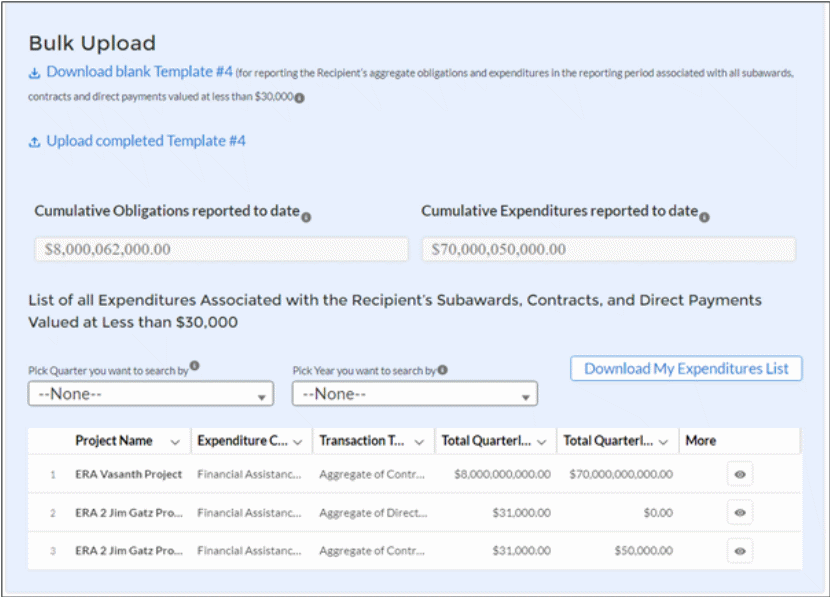
Figure
112 – Display of Cumulative Amounts Obligated and Expended
(Associated with Obligations of Less then $30,000)
ERA2 Recipient Expenditures (Payments) to Individuals (see Figure 113)
Enter the Total Amount Expended and Total Amount Obligated for payments to individuals in the quarter.
Select the relevant ERA2 Project from the Project Name drop-down list. Remember ERA2 Recipient may have multiple Projects including the Emergency Rental Assistance Project, one or more Affordable Rental Housing Project(s) and one or more Eviction Prevention Project(s).
Select the associated Expenditure Category from the drop-down picklist.
Click the Save Data Entry button located at the lower left of the screen to submit the record. Depending on the obligations and expenditures performed in the reporting period, Steps 1 & 2 will need to be repeated for each of the 7 Expenditure Category types.
Treasury’s portal will display an on-screen summary of the reported quarterly obligations and quarterly expenditures to individuals in tabular format. Please see Appendix C for a sample of the table. The sample may be particularly helpful for Recipients who manually key-in these data points.
Cumulative Expenditures and Cumulative Obligations displays the sum of all records reported in this section from award date through the end of the reporting period. These fields are automatically calculated and displayed at the bottom of the subsection (see Figure 114).

Figure 113 – Manual Input Screen for Aggregate Obligations and Expenditures in the Quarter Related to Payments to Individuals


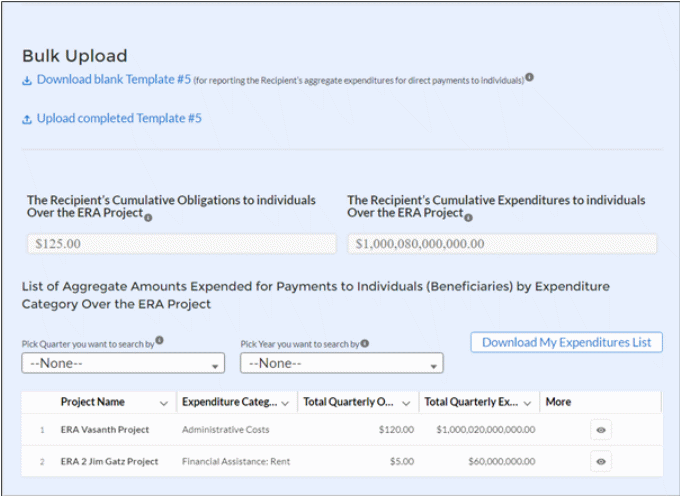
Figure
114 -- Display of Cumulative Amounts Obligated and Expended to
Individuals
Update/Delete Expenditure Records
The user can only delete Expenditure Records it created in the current reporting period.
ERA2 Recipients are not able to update or delete expenditure records after the quarterly report in which they are initially created has been submitted.
To reflect changes to previously reported expenditures, the ERA2 User should create a new expenditure record associated with the subaward that needs to be updated. For example, if the Recipient previously reported expending $100,000 under a subaward but later realized the expenditure amount was $110,000, the Recipient should create a new expenditure record associated with the subaward, in the amount of $10,000.
Click the Next button on the navigation bar to advance to the next section.
![]()


ERA2 Recipients use this tab to report cumulative total amounts for 13 measures over the period from the date of receipt of the ERA2 award through the end of the reporting period.
The tab includes five tables/sections:
1) Cumulative Number of Households that Submitted an Application / Received Assistance.
2) Cumulative Number of Households that Received ERA2 Assistance by Type.
3) Cumulative Number of Unique Participant Households at Certain Income Levels.
4) Cumulative Number of Unique Participant Households Whose Income Eligibility was Determined by Other Methods; and
5) Average Number of Months of Rent, Rental Arrears, Utility/Home Energy, and Utility/Home Energy Arrears.
Recipients must manually enter their responses on this tab.
For any data fields that do not apply, please enter “0.”
Recipients are required to report these cumulative amounts broken out
by Race, Ethnicity, and Sex of the participant households on the
following tab.
Under the Cumulative Number of Households that Submitted an Application / Received Assistance section (see Figure115), report data on ERA2 applications received and assistance provided from the date of receipt of the ERA2 award to the end of the reporting period. Note, questions 1A and 2A require cumulative data, but question 1B requires quarterly data only.
Figure115 – Numbers of
Applications Received and Households Receiving Assistance
Under the Cumulative of Households that Received ERA2 Assistance by Type section (see Figure116), report data on the cumulative number of unique households that had received the different types of ERA2 assistance from the date of receipt of the ERA2 award through the end of the reporting period.

Figure 116 –
Cumulative Number of Households that Received ERA2 Assistance
Under the Cumulative Number of Unique Participant Households at Certain Income Levels, report data on households served based on income eligibility (see Figures 117 and Figure 118).
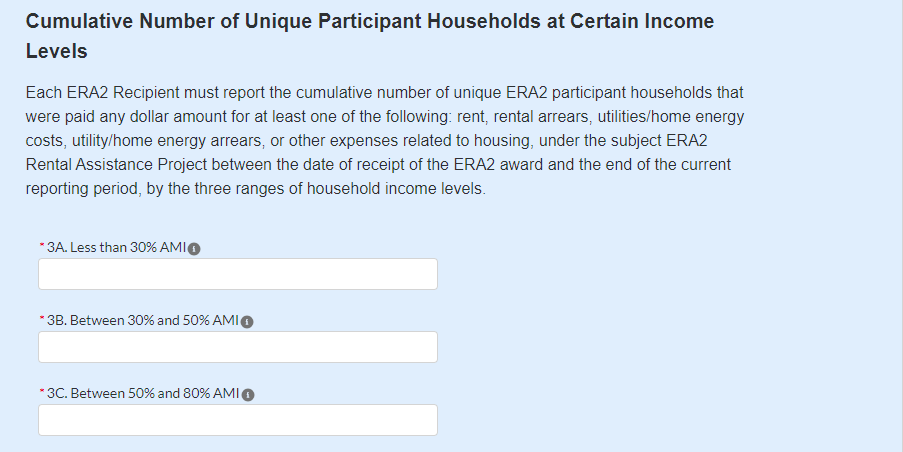
Figure 117 – Cumulative Number of Unique Participant Households at Certain Income Levels
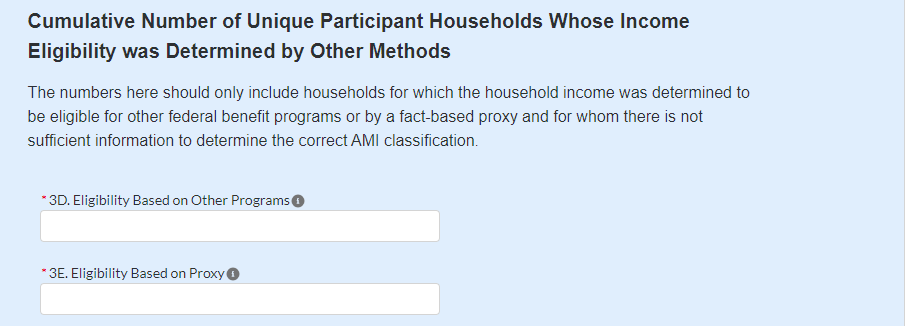
Figure 118 – Cumulative Number of Unique Participant Households Whose Income Eligibility was Determined by Other Methods
The cumulative numbers reported here should only include those households for which the Recipient determined that the household was eligible for ERA2 assistance based on the household’s eligibility for other federal benefit programs or based on information provided via a fact-based proxy and for whom there is not sufficient information to determine the correct AMI classification.
Under the Average Number of Months of Rent, Rental Arrears, Utility/Home Energy, and Utility/Home Energy Arrears section, report data on average amounts paid over the period from receipt of the ERA2 award through the end of the current quarterly reporting period.

Figure 119 – Input Screen for Average Number of Months of Rent, Rental Arrears, Utility/Home Energy, and Utility/ Home Energy Arrears
Click the Save Emergency Rental Assistance Project Data button to record progress.
![]()
Click the Next button to advance to the Emergency Rental Assistance Project Participant Demographics Data tab.
![]()
Emergency Rental Assistance Project Participant Demographics Data Tab
ERA2 Recipients use this tab to report their ERA2 Emergency Rental Assistance Project participant demographic information. (Please note: No data on Affordable Rental Housing or Eviction Prevention is reported on this tab)
ERA2 Recipients must report cumulative information by race, ethnicity, and sex of the primary applicant of the participant household. Please refer to the ERA Reporting Guidance for additional information.
Populate each of the five tables in this tab with cumulative data from the date of ERA2 award through the end of the reporting period.
For Tables 1, 2, 3 and 5, please report cumulative demographic information for each question. The portal will sum the inputted disaggregated information and display the total for each demographic category (race, ethnicity, and sex) in each column.
Manually enter each data element as a whole number or zero (no negative numbers, decimals, or fractions). For any data fields with no data, please enter “0.”
After entering or editing the required data in each table (and inputting zeros where there is no data), click the SAVE button immediately below the table. Upon clicking the SAVE button, the portal will examine and validate the inputted data and provide error messages, if needed, so grantees can adjust the inputted data if needed, before moving to the next table.
Table 1 – Number of Unique Households
Users must provide cumulative information for the two questions shown on the Table 1 (see Figure 120), disaggregated by race, ethnicity and sex of participant households as shown below.
The portal will sum the inputted disaggregated information and display the total for each demographic category (race, ethnicity, and sex) in each column.
To aid the recipient in reporting consistently, the portal will display the cumulative total number for each question as entered by the recipient on the previous tab, “Emergency Rental Assistance Project Data.”
Column 1A. Applications Submitted, is defined as “Number of unique households that completed and submitted an application for ERA2 Emergency Rental Assistance cumulatively from award date through the end of the reporting period.”
Please enter the cumulative number of unique households that completed and submitted an application for ERA2 Emergency Rental Assistance from award date through the end of the reporting period, broken out by race, ethnicity, and sex of the head of household.
Column 1B. Households Receiving Initial Assistance in the Quarter, is defined as “Number of unique households that received their initial ERA2 assistance in the current quarterly reporting period.”
Please enter the total number of unique households that received their initial ERA2 Emergency Rental Assistance in the current quarterly reporting period broken out by race, ethnicity, and sex.
Click on the pencil icons to open each text boxes to enter your data. You must enter a number greater than or equal to zero “0” for each item. Please enter a zero “0” to represent none.
First enter responses for all categories in the Question 1A column and next enter responses for each disaggregated data category in the Question 1B column.
When complete with no error flags, click the “Save” button and go to Table 2.
Table 1 – Number of Unique Households
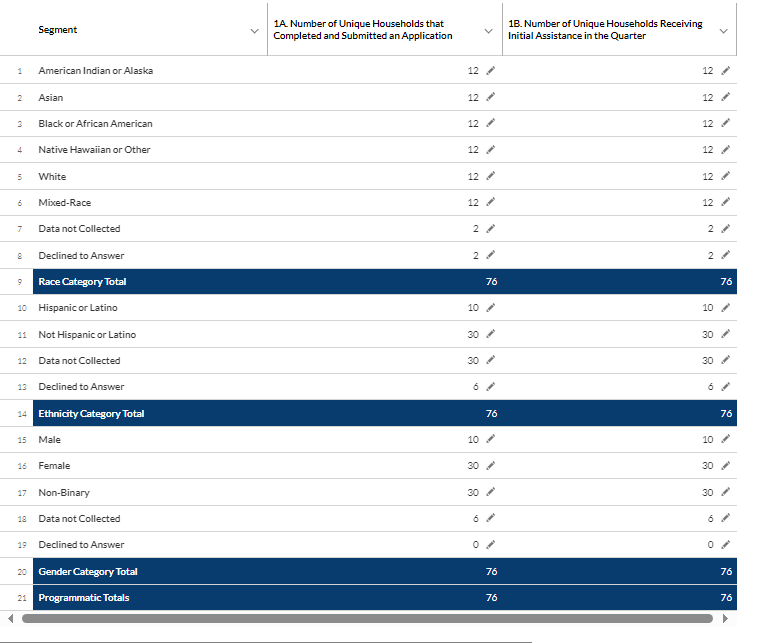
Figure 120 – Table 1 Input Screen
 Data
Validations on Table 1
Data
Validations on Table 1
The
portal has built-in verifications to ensure the data entered in Table
1 is complete and logically consistent within the three categories,
within each column, and across the columns.
Example 1: The portal will alert the grantee of a reporting error if the user enters figures (such as 100) in Question 1A for the number of Males who submitted an application and enters a larger figure (such as 1,000) in Question 1B for the number of Males who received assistance for the first time in the quarter.
In this example, it is not logically possible that a total of 100 unique Males submitted applications while a total of 1,000 unique Males received assistance in the quarter. The number who received assistance cannot be larger than the number who submitted an application. When the portal displays a flag, it will indicate the rows that appear to contain inconsistent data. The user should review the inputted information and make revisions as needed.
In addition, Table 1 requires that the totals for each column displayed in the dark-shaded rows labeled “Race Category Total,” “Ethnicity Category Total,” and “Sex Category Total” must be equal.
Finally, users must complete each field on Table 1. Please enter zero “0” in any field where there is no data to report.
Table 2 – Number of Households by Assistance Type
On Table 2, users must provide cumulative demographic information for the six questions. The information must be disaggregated by race, ethnicity and sex as shown below. The portal will sum the inputted disaggregated information and display the total for each demographic category (race, ethnicity, and sex) in each column.
Column 2A. Cumulative Number of Households Receiving ERA2
Assistance, which is the “Number of unique households that
received ERA2 Emergency Rental Assistance cumulatively from award
date through the end of the reporting period.”
Please enter the cumulative number of unique households that received ERA2 Emergency Rental Assistance of any type from award date through the end of the reporting period, broken out by race, ethnicity, and sex of the head of household.
Columns
2B, 2C, 2D, 2E and 2F. Cumulative Number of Households Receiving Each
Type of ERA2 Rental Assistance from award date through the end of the
reporting period.
Please enter the cumulative number of unique households that received ERA2 Emergency Rental Assistance by type (Rent, Rental Arrears, Utilities/Home Energy, Utilities/Home Energy Arrears, and Other Expenses Related to Housing) from award date through the end of the reporting period, broken out by race, ethnicity, and sex of the head of household.
As with Table 1, to enter data on Table 2, click on the pencil icon to open a small text box where you can enter whole numbers. Users must enter a numeral for each item. Please enter a zero “0” to represent none.
Users must enter responses for all categories under Columns 2A, 2B, 2C, 2D, 2E and 2F sequentially, starting with the item in Column 2A.
When Table 2 is complete, click ‘Save’, before proceeding to Table 3.
Table 2 – Number of Households by Assistance Type
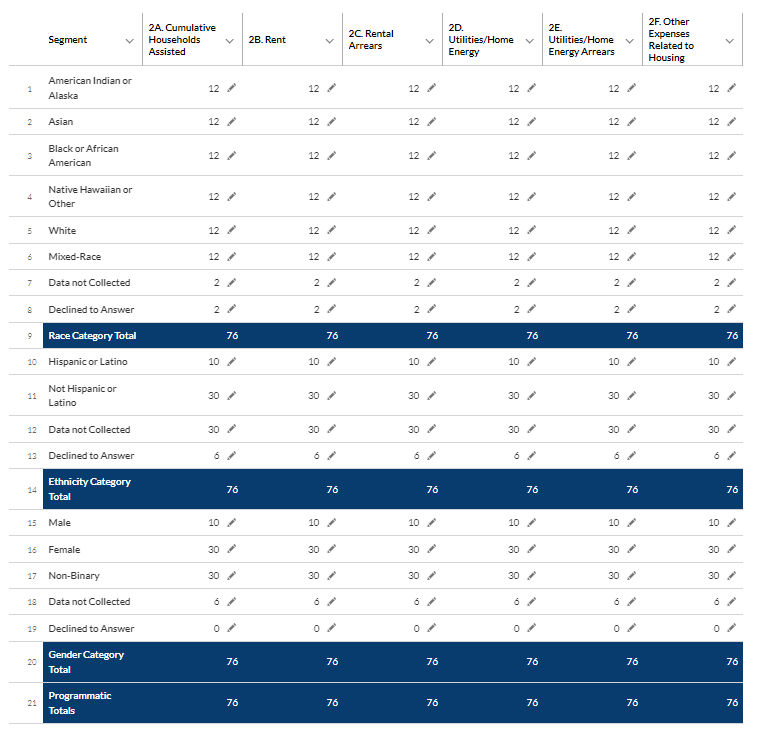
Table 121 – Cumulative Numbers of Households by Type

Data Validations on Table 2
Like Table 1, the portal has built-in verifications to ensure the data entered in Table 2 is complete and logically consistent. Please see the following examples.
Example 1: The portal will alert the grantee and prohibit submission of values for any demographic segment (race, ethnicity, and sex) on Table 2, Question 2A that is greater than the values inputted for the demographic segments on Table 1, Question 1A.
This data validation check is ensuring that the figures reported for Question 1A (cumulative number of unique households that had submitted an application) is not less than the figures reported for Question 2A (cumulative number of households that had received assistance from the award date through the end of the reporting period.
Example 2: The portal will display an error if the total for any demographic segment (race, ethnicity, and sex) entered under Question 2A (cumulative number of households in that demographic segment who received any form of assistance from award date through the end of the reporting period) is less than an entry in any of the demographic segments (rows) in any of the Columns – that is Columns 2B, 2C, 2D, 2E and 2F.
For example, if a recipient reports that 100 unique Hispanic or Latino households received any form of assistance between award date and the end of the reporting period (by inputting 100 in Column 2A, row 10) and the recipient also reports that 150 unique Hispanic or Latino households received rental assistance (by inputting 150 in Column 2B, Row 10), that would be a violation of the validation rule. That is, the number who received rental assistance cannot be larger than the number who receive all forms of assistance.
When entering data in Table 2, users should make certain that for each column, the amounts displayed in the dark-shaded rows labeled “Race Category Total,” “Ethnicity Category Total,” and “Sex Category Total” are equal.
Finally, users must complete each field on Table 2. Please enter zero “0” in any field where there is no data to report.
Table 3 – Number of Households by Income and Other Eligibility Methods
On Table 3, users must provide cumulative disaggregated demographic information for the six questions shown on the table. The information must be disaggregated by race, ethnicity and sex as shown below (see Figure 121).
The portal will sum the inputted disaggregated information and display the total for each demographic category (race, ethnicity, and sex) in each column.
To aid the recipient in reporting consistently, the portal will display the totals for each column as entered by the recipient on the previous tab, “Emergency Rental Assistance Project Data.”
Columns 3A, 3B and 3C. Cumulative Number of Households that
Received ERA2 Emergency Rental Assistance of any type by income
level, defined as “Cumulative Number with Household Income
of less than 30% of Area Median Income;” “Cumulative
Number with Household income of between 30% and 50% of Area Median
Income;” and “Cumulative Number of Households with
Incomes of between 50% and 80% of Area Median Income.”
Please enter the cumulative number of unique households that received ERA2 Emergency Rental Assistance of any type from award date through the end of the reporting period broken out by income level, with each level disaggregated by race, ethnicity, and sex of the head of household.
Column 3D. Household Eligibility Based on Eligibility for other Federal Benefits. Users must enter the “Cumulative Number of unique households whose income eligibility was determined based on their eligibility for other federal benefit programs.”
Please enter the cumulative number of unique recipient households whose income eligibility was determined based on their eligibility for other federal benefit programs. The numbers reported for this item should only reflect the number of households for which the household income was determined to be eligible for other federal benefit programs and for whom there is not sufficient information to determine the correct AMI classification.
Column 3E. Household Eligibility Determined using Fact-Based Proxy. Users must enter the “Number of unique households whose income eligibility was determined used a fact-based proxy.”
Please enter the cumulative numbers of unique households (from award date through the end of the current reporting period) of unique households whose income eligibility was determined using a fact-based proxy. The numbers reported for this item should only reflect the number of households for which the household income was determined based on a fact-based proxy and for whom there is not sufficient information to determine the correct AMI classification.
Column 3F. Cumulative Amount of ERA2 Funds Paid to/for Participant Households. Users must enter the “Total amount of ERA2 funds paid cumulatively from award date through the end of the reporting period to or for participant households.”
Please enter the cumulative amounts of ERA2 funds paid to/for participant households from award date through the end of the reporting period, disaggregated by race, ethnicity, and sex of the head of household.
Like
Tables 1 and 2, you must click on the pencil icon to open a small
text box where you can enter whole figures. ERA2 Recipients must
enter a figure for each item. Please enter a zero “0” to
represent none.
Please enter responses for all categories under Columns 3A, 3B, 3C, 3D, 3E and 3F sequentially, including each disaggregated data category, starting with Column 3A.
To aid the recipient in reporting consistently, the portal will display the totals for each column as entered by the recipient on the previous tab, “Emergency Rental Assistance Project Data.”
When Table 3 is complete, click ‘Save’, before proceeding to Table 4.
Table 3 – Number of Households by Income and Other Eligibility Methods

Figure 122 – Cumulative Numbers of Households by Income and Other Eligibility Methods

Data Validations on Table 3
Table 3 data validations ensure consistency for each demographic segment (race, ethnicity, and sex) on Questions 3A, 3B, 3C, 3D and 3E with the figures reported Table 2, Question 2A.
Specifically, the portal will indicate an error when the sum of amounts reported in Questions 3A + 3B + 3C + 3D + 3E is greater than the amounts reported in corresponding segments as reported in Table 2, Column 2A.
Example: The total number of Asian households that received assistance (which is the sum of the number in each income category shown on Table 3, Columns 3A + 3B + 3C + 3D + 3E) cannot logically be greater than the cumulative number of Asian households that have received assistance from the ERA2 award date through the end of the current reporting period as reported on Table 2 Question 2A.
As on Tables 1 and 2, when entering data in Table 3, users should make certain that for each column, the amounts displayed in the dark-shaded rows labeled “Race Category Total,” “Ethnicity Category Total,” and “Sex Category Total” are equal.
Finally, users must complete each field on Table 3. Please enter zero “0” in any field where there is no data to report.
TABLE 4 – AVERAGE NUMBER OF MONTHS OF ASSISTANCE
In Table 4, ERA2 Recipients must report the average number of months that participant households received ERA2 rental or utility assistance between the date of receipt of the ERA2 award and the end of the current reporting period, disaggregated by race, ethnicity, and sex of the participant household’s head of household (see Figures 123).
ERA2 Recipients must also report disaggregated data on the average number of months that participant households received each type of assistance (rent, rental arrears, utility/home energy costs, utility/home energy costs arrears) between the date of receipt of the ERA2 award and the end of the current reporting period.
Please enter each response with up to two decimal points, for example 52.5 to represent 52.5 percent. For any data fields with no data, please enter “0.”
To aid the recipient in reporting consistently, the portal will display the totals for each column as entered by the recipient on the previous tab, “Emergency Rental Assistance Project Data.”
When finished entering data on Table 4, click the Save button to move to Table 5.
Table 4 – Average
Number of Months of Assistance

Figure 123 – Average Number of Months of Assistance
TABLE 5 -- CUMULATIVE AMOUNTS OBLIGATED AND EXPENDED
In Table 5, ERA2 Recipients must enter cumulative amounts for
six obligation and expenditure measures from date of receipt of the
ERA2 award through the end of the reporting period (see Figure 124).
The
portal will pre-populate the first item on Table 5 with information
the grantee inputted on the Project Overview Tab dashboard (see
Figures 29 and 30). Grantees must manually enter responses to the
remaining questions on Table 5.
Total
dollar amount of ERA2 funds paid cumulatively from award date through
the end of the reporting period to or for participant households.
Users must input the cumulative dollar amount of ERA2 award
funds paid under the ERA2 Emergency Rental Assistance Project to or
for participant households including payments for rent, rental
arrears, utility/home energy costs, utility/home energy arrears, and
other housing services and eligible expenses. Do not include amounts
paid for housing stability services provided under this project.
Total
dollar amount of ERA2 fund paid (expended) for administrative
expenses cumulatively from award date through the end of the
reporting period.
Users must input the total dollar amount
of the ERA2 award the Recipient (and its subrecipients and
contractors, as applicable) expended for administrative expenses
under the ERA2 Emergency Rental Assistance Project cumulatively from
award date through the end of the reporting period.
Total
dollar amount of ERA2 funds obligated for administrative expenses
cumulatively from award date through the end of the reporting period.
Users must enter the dollar amount of the ERA2 award the
Recipient (and its subrecipients and contractors, as applicable) has
obligated for payment for administrative expenses under the ERA2
Emergency Rental Assistance Project cumulatively from award date
through the end of the reporting period. The cumulative amount
obligated should reflect the cumulative amount the Recipient has paid
or agreed to pay for administrative expenses, as evidenced by a
legally binding agreement or contract.
Total
dollar amount of ERA2 award funds paid (expended) for housing
stability services cumulatively from award date through the end of
the reporting period.
The user must input the total amount
of the ERA2 award the Recipient (and its subrecipients and
contractors) paid for housing stability services (including eviction
prevention/diversion) under the ERA2 Emergency Rental Assistance
Project cumulatively from award date through the end of the reporting
period. Note, this should include only housing stability expenditures
under the ERA2 Rental Assistance Project and exclude expenditures
under any ERA2 Eviction Prevention Project(s).
Total
dollar amount of ERA2 award funds obligated for housing stability
services cumulatively from award date through the end of the
reporting period.
The user must input the total amount of
the ERA2 award the recipient (and its subrecipients and contractors,
as applicable) obligated for housing stability services (including
eviction prevention/diversion) under the ERA2 Emergency Rental
Assistance Project cumulatively from award date through the end of
the reporting period. Note, this should exclude obligations under any
ERA2 Eviction Prevention Project(s).
Cumulative
number of unique participant households that received housing
stability services under the ERA2 Emergency Rental Assistance project
from award date through the end of the reporting period.
Users
must report the number of unique households that have received
housing stability services directly from the Recipient or from any
subrecipient(s) / contractor(s) under the ERA2 Emergency Rental
Assistance Project. Do not include households that have received
housing stability services under an ERA2 Eviction Prevention project
only.
When complete, click the “Save” button.
Table 5 – Cumulative Amounts Obligated and Expended
Pre-populated:
Total cumulative Expenditures for the Emergency Rental Assistance Project between date of receipt of the ERA2 award through the end of the current reporting period.
Manual entry:
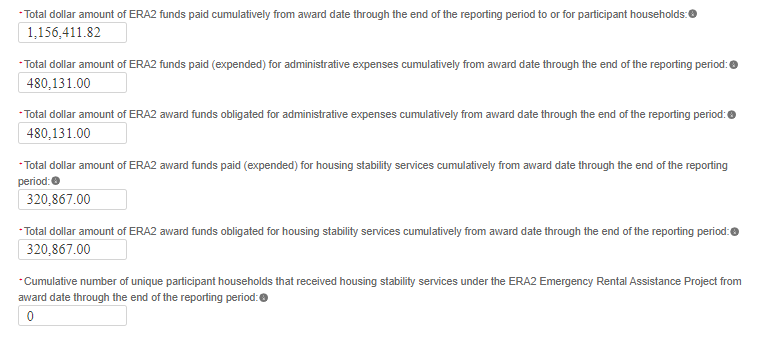
Figure 124 – Cumulative Amounts Obligated and Expended, ERA2 Rental Assistance Project
When ready, click the “Next” button to go to the Performance and Financial Reporting tab.
![]()

Data Validations on Table 5
The portal has built-in verifications to ensure the data entered in Table 5 is accurate. Please see the following examples.
Example 1: The portal will raise a data validation error message if the sum of the three expenditure data points entered in is Table 5 (listed below) does not equal the total cumulative expenditures for the ERA2 Emergency Rental Assistance Project as shown on the “Project Overview Tab” dashboard. (Note, for reference, the total cumulative expenditures as shown on the “Project Overview Tab” dashboard is displayed at the top of the Table 5 screen.)
The three expenditure data points are as follows:
Total dollar amount of ERA2 funds paid cumulatively from award date through the end of the reporting period to or for participant households.
Total dollar amount of ERA2 fund paid (expended) for administrative expenses cumulatively from award date through the end of the reporting period.
Total dollar amount of ERA2 award funds paid (expended) for housing
stability services cumulatively from award date through the end of
the reporting period.
Example
2: The portal will raise a data validation error when the
recipient reports that the total dollar amount of ERA2 funds paid
(expended) for administrative expenses cumulatively from award
date through the end of the reporting period is less than the
cumulative amount obligated for administrative expenses.
Example
3: The portal will raise a data validation error when the
recipient reports that the total dollar amount of ERA2 funds paid
(expended) for housing stability services cumulatively from
award date through the end of the reporting period is less than the
cumulative amount obligated for housing stability services.
Performance and Financial Reporting Tab
In this tab, you will report on the overall performance and financial information for the ERA2 award overall. Please refer to the ERA Reporting Guidance for additional clarification.
This
tab includes four segments:
a) Performance Narrative.
b) Narrative on Effective Practices.
c) Federal Financial Reporting; and
d) Participant Household Payment Data File.
Please provide a narrative (or revised previously submitted narratives) on the performance of the overall ERA2 activities relative to the outlined ERA2 goals and outcomes over the current reporting period (see Figure 125).
Provide a narrative that discusses the ERA2 activities relative to the goals. Address all the listed relevant points.
Alternatively, you can upload the performative narrative via the “Upload Files” functionality. For ease of tracking, please use the following naming convention:
ERA2-XXXX_Performance_Narrative_Qx_20xx.
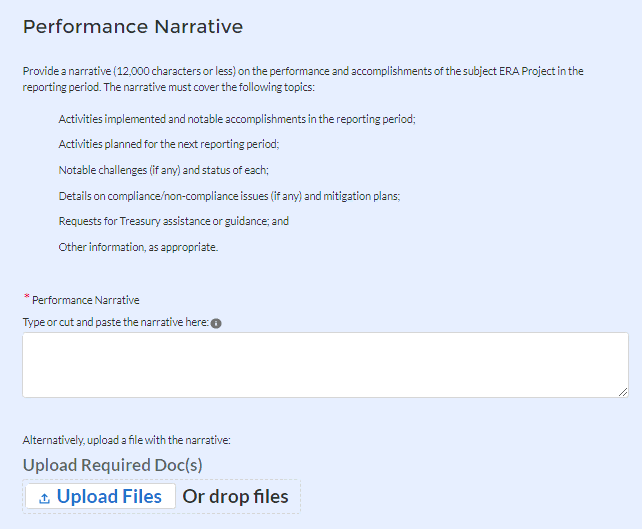
Figure 125 – Performance Narrative
We encourage you to provide information on any practices you have used in administering the ERA2 award that you consider “effective practices” that may be helpful and shared with other ERA2 grantees.
Provide a brief explanation on any “effective practices” used when administering any aspect of the ERA2 award including any component ERA2 Projects (see Figure 126).
Alternatively, upload your effective practices narrative via the “Upload Files” functionality. For ease of tracking, please using the following standard file naming convention:
ERA2-XXXX_Effective_Practices_ Qx_20xx.

Figure 126 – Narrative on Effective Practices
Federal Financial Reporting
ERA2 Recipients must provide the following information (see Figure 127).
Near the top of the screen, the portal will display the current Total Award Amount, which will be prepopulated by the portal. On the example shown in Figures 127, the amount is shown as $1,000,000. ERA2 Recipients should review the amount for accuracy.
ERA2 Recipients must report the following financial information for their entire ERA2 Award (Based on the sum of obligations and expenditures across rental assistance, affordable rental house, and eviction prevention projects):
Cash Receipts (SF-425 Item 10a)
Cash Disbursements (SF-425 Item 10b)
Cash on Hand (SF-425 10c)
Total Federal funds authorized (SF-425 Item 10d)
Federal share of expenditures (SF-425 Item 10e)
Federal share of unliquidated obligations (SF-425 Item 10f)
Total Federal Share (Sum of SF-425 items 10e and 10f)
Unobligated balance of Federal Funds (SF-425 Item 10d minus 10g)
Current Quarter Obligations
Current Quarter Expenditure
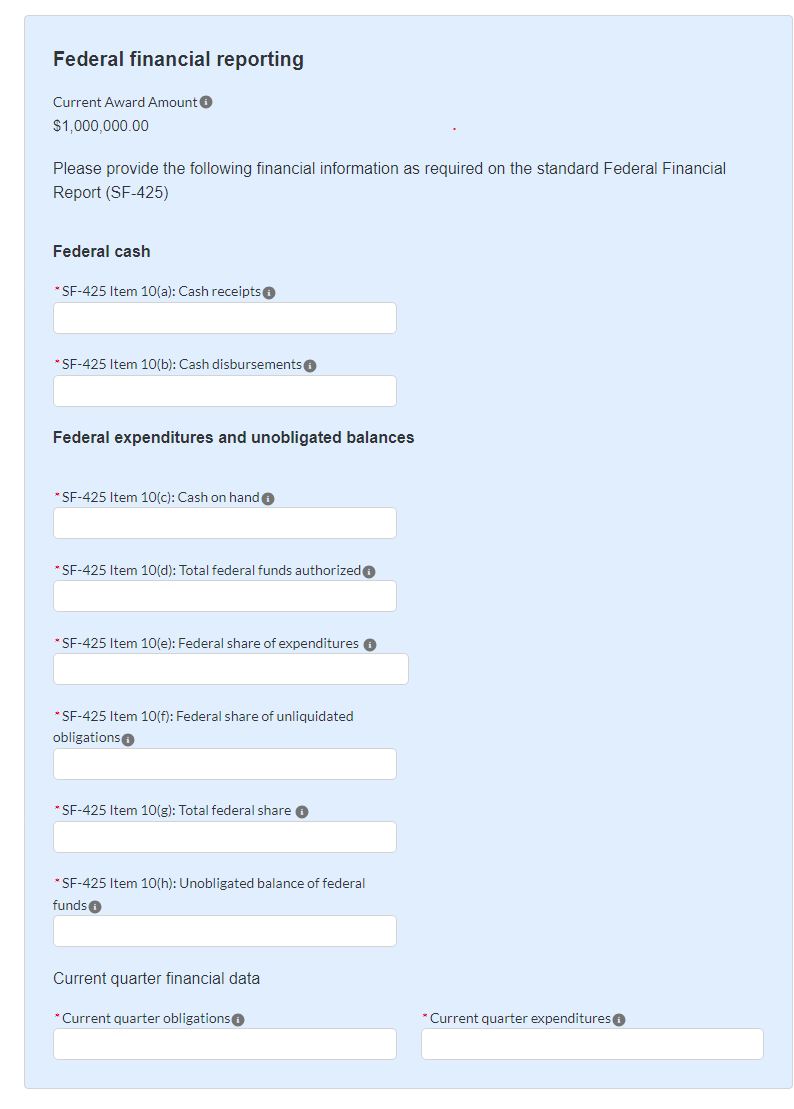
Figure
127 – Federal Financial Reporting
Participant Household Payment Data
All ERA2 Recipients must provide a Participant Household Payment Data File containing details on each payment made to each unique household that has received, either directly or indirectly, a payment of ERA2 funds from the subject ERA2 Emergency Rental Assistance Project from date of receipt of the ERA2 award through the end of the reporting period. Please see the ERA2 Reporting Guidance for additional information.
It is very important that Recipients submit the Participant
Household Payment Data using Template 7. Please take care to
populate Template 7 with complete data and in the correct format.
Please refer to the Special Reporting Tip – Participant Household Payment Data File (Template 7) Guide and Checklist for detailed instructions on submitting the required data using Template 7. (https://home.treasury.gov/system/files/136/ERA-Tip-Template-7.pdf) The guide and accompanying checklist are handy references for ensuring the Recipient inputs the data correctly on Template 7 before uploading the file into the portal.
ERA2 Recipients must use the bulk file upload capability to submit the required data.
To
upload a completed Participant Household Payment Data section, click
the Upload
Files icon
(see
Figure124) and attach the Participant Household Payment Data File
(*.csv). The file can be downloaded by clicking the Download
Participant Household Payment Data icon.
For ease of tracking, please use the following standard
file naming convention:
PHPDF QX YYYY SLTXXXX.csv (remove the spaces)
PHPDF
Qx = the quarter (for example Q1, Q2, Q3 or Q4)
YYYY
= the reporting year
SLTXXXX = the SLT-XXXX application number
associated with the ERA2 award
Please do not include spaces or use other characters in the file name.
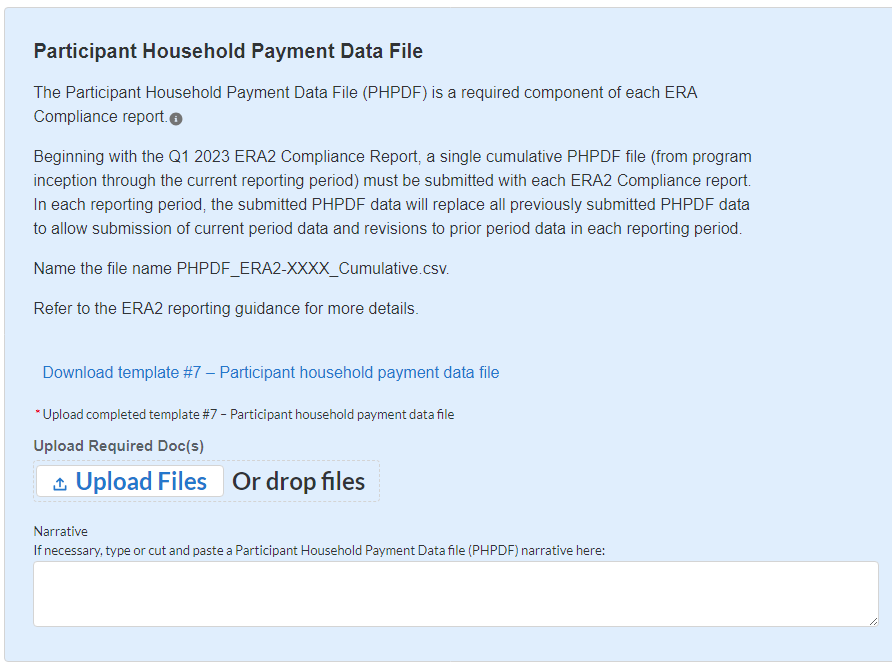
Figure 128 – Participant Household Payment Data File
Recipient Comments
Users may use the Recipient Comments section to provide any
information or comments to Treasury about data being reporting,
technical issues encountered with the portal, or other aspects of the
compliance reporting process.
Recipients are encouraged
to provide any information deemed necessary to further explain any
data or narrative responses submitted in the quarterly report as
well. Users can upload a file or use the provided text box to provide
comments (see Figure 129).
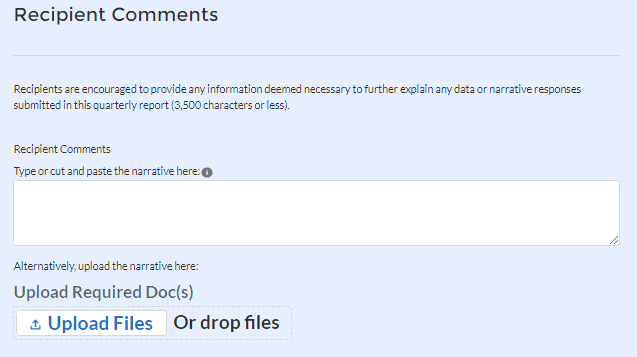
Click the Save Performance and Financial Report button to record progress.
![]()
Click the Next button to advance to the Report Certification and Submission module.
![]()
The ERA2 Recipient’s designated Authorized Representative for Reporting (ARR) or ERA Account Administrator (AA) must e-sign the certification to successfully submit a Quarterly Report (see Figure 130).
If the ERA2 Point of Contact attempts to certify the submission, the report will be in “Draft” status until the ERA2 ARR or AA certifies through the portal.
The certification and submission process involves several steps.
First, the ERA2 ARR or AA must enter their name and contact information and click the “Certify & Submit” button at the bottom of the screen to indicate their certification statement.
Review and agree to the following statement:




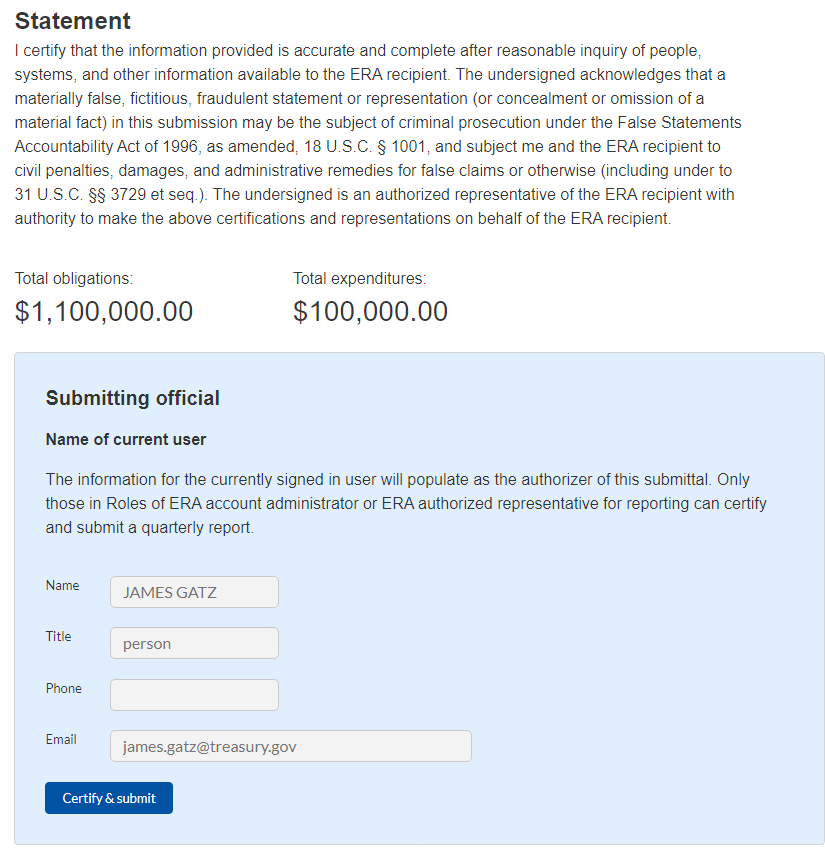
Figure 130 – Report Certification and Submission
When the ARR or AA certifies, a window will pop up to ensure the report is ready to be submitted. At that point, the ARR or AA should Click the “Certify & Submit” button (see Figure 131).


Figure 131 – Validation Success Pop-Up
The portal will review the submitted form and, if there are no data validation issues, the portal will display a pop-up box indicating “Validate Success” as shown in Figure 131.
If the portal identifies errors, omissions, or inconsistencies at the time of your submission, a “Submission Error” will appear and will list the issues to be revised / corrected in red (see Figure132).


Figure132 – Submission Error Pop-Up
Address all errors and repeat the Certification and Submission to successfully submit the report. Certify and successfully submit your report.
When the report is successfully submitted, the Quarterly Reporting process is complete.

Validation of Cumulative Obligations and Cumulative Expenditures
The Certification and Validation screen will display the ERA2 Recipient’s “Total Obligations” and “Total Expenditures” immediately above the blue box that shows the Submitting Official’s credentials, as highlighted by the red box in the screen snippet below.

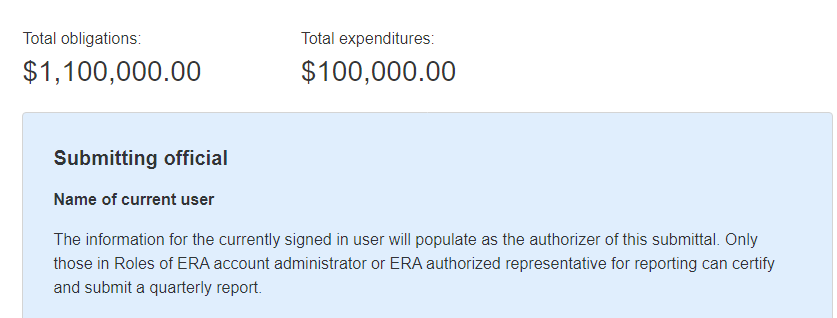
Total Obligations and Total Expenditures as displayed on the Certification and Validation Screen
The “Total Obligations” amount is the cumulative amount of all ERA2 obligations made by the ERA2 Recipient from the date of receipt of award through the end of the reporting period, as reported in past and current quarterly reports. This includes all obligations as reported for all ERA2 Projects (rental assistance, affordable rental housing, and eviction prevention projects) administered by the ERA2 Recipient.
Similarly, the “Total Expenditures” amount is the cumulative amount of all ERA2 expenditures made by the ERA2 Recipient from the date of receipt of award through the end of the reporting period, as reported in past and current quarterly reports. This includes all expenditures as reported for all ERA2 Projects administered by the ERA2 Recipient.
These amounts are calculated by the portal based on information the ERA2 Recipient has reported on the “Recipient Subawards, Contracts and Direct Payments” tab and the “Expenditures” tab as follows:
Note: The amounts displayed on the Certification and Validation screen must equal the cumulative amounts displayed on the ERA2 Recipient’s My Project Dashboard on the Project Overview screen as shown below. The amounts displayed on the My Project Dashboard is the sum of cumulative obligation and expenditure amounts the ERA2 Recipient entered on the My Project Dashboard Pop-Up screens for each of its ERA2 Projects.
(Continued on Next Page)


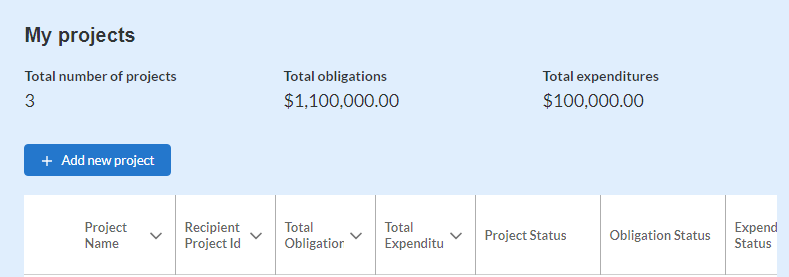
As displayed on the Project Overview tab, My Projects Dashboard
If the amounts displayed on the Certification and Validation Page do not correctly reflect the ERA2 Recipient’s records the user should review the amounts reported as obligated and the amounts reported as expended on the “Recipient Subawards, Contracts and Direct Payments” tab and the “Expenditures” tabs. In addition, the User should ensure that the amounts reported on the Project Overview My Project Dashboard are correct and align with the ERA2 Recipients records.
Appendix A – Bulk File Upload Overview
Appendix A provides an overview of the ERA bulk file upload process. There are seven (7) unique bulk file upload templates listed below in the order in which they should be populated and submitted to the ERA Treasury portal. A copy of each template can be downloaded directly from the Bulk Upload Templates and Instructions Tab on the ERA quarterly report.
Template #1 – Subrecipient, Contractor, Beneficiary Profile
Template #2 - Subaward, Contract, Direct Payment Record
Template #3 - Reporting Expenditures associated with all Subawards, Contracts and
Direct Payments valued at $30,000 or more
Template #4 - Reporting Obligations and Expenditures associated with all Subawards, Contracts and Direct Payments valued at less than $30,000.
Template
#5 - Reporting Recipient Obligation and Expenditures to Individuals
Template
#6 – This template was used only prior to Q3 2023.
Template
#7 - Participant Household Payment Data File
Template Descriptions
Each Tab or section in the portal provides a link to applicable bulk upload template. Each of the templates have the same structure as described below:
Row 1: Template Version
Row 2: Template Name
Row 3: Instructions: Brief description of the template constraints and download/upload guidance
Row 4: Field IDs: Column identifiers
Row 5: Field Label: Brief description of each Field or Column
Row 6: Required or Optional: This field specifies if the field is optional or required. When the column is required, and a recipient does not provide the required data, the system will not accept any record or allow the file to be uploaded.
Row 7: Field Help Text: Provides a description of the column. There are 2 types of fields, 1). an open value either text or numbers and 2). A predefined list of picklist values:
Open Value: Any text or number. Text for State name or Last Name or a Number that represents amounts. Most text types are free formats, the only expectation is for Dates, each column that represents a date describes the accepted format. For any number field, it is not required to add “,” to represent thousands or it is not required to add “$” to represent currency. Only add decimal “.” when needed.
Picklist: A predefined list of values that is accepted by the system. When the column is a picklist, row 7 provides the list of options that the system accepts. Recipients should “copy and paste” the valid value for each record. If the recipient provides a value that is not in the predefined picklist, the system will not accept the file. Responses should not contain double quotes.
Row 8: Data that Recipient submits. Row 8 is where recipients insert specific data to submit. The system accepts 1 or many rows.
The following is special guidance for each row or set of rows:
Do not change the content of rows 1 to 7.
Rows 4 to 7 provide metadata of each data element or column of the information that Recipients will provide.
Start adding your data in row 8 column B.
The following is an example of a template:
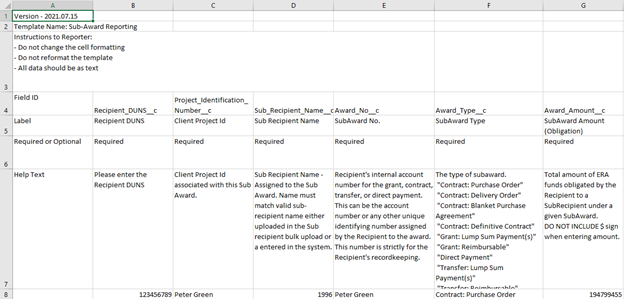
Figure 133 – Example Bulk Upload Template
Bulk Upload Template Download and Upload Steps
The Template download and upload process involves the following steps:
Download the template from the Bulk Upload Templates and Instructions tab.
Open the template in Microsoft Excel.
Users should add data starting with row 8, column B of the template.
When finished adding data for row 8, users should repeat on additional rows as required.
Save the template as a .CSV file and change the name of the file if needed.
Click the Bulk Upload link to open the Bulk Upload box (see Figure 135).

Figure 135 – Bulk Upload Pop-Up Message
Attach the saved .CSV file by clicking on “Upload Files”, alternatively users can drag the file to the designated area.
A message will appear confirming that the file is uploaded (see Figure 135). Click “Done”.

Figure 135 – Upload Files Message
The file will be listed at the bottom of the bulk upload window. (See Figure 136).
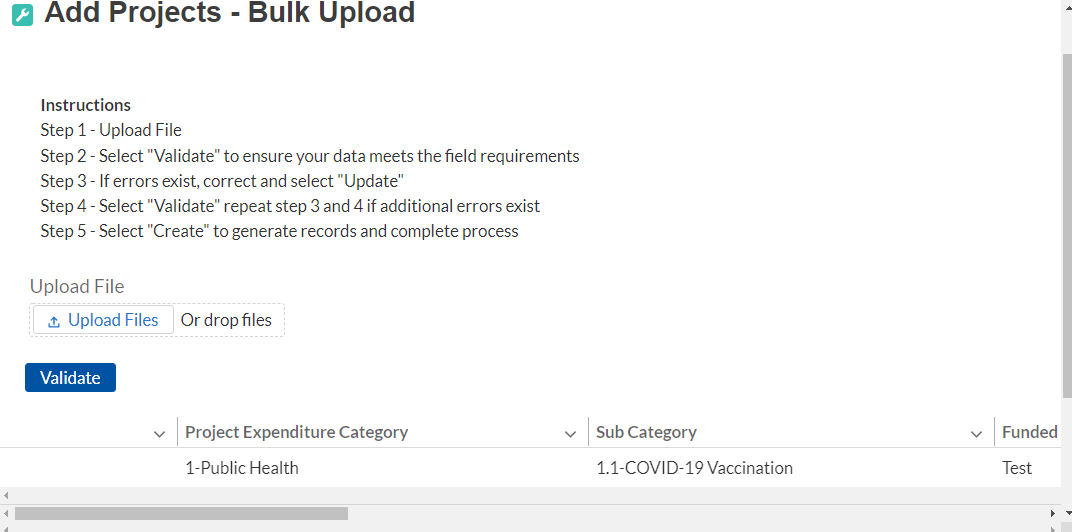
Figure 136 – File added to Bulk Upload portal.
Click “Validate” to have the system verify the bulk upload does not have errors.
If the system validation finds errors in the bulk upload file, it will return the screen with the list of the errors. (See Figure 137). From here, users can either update on the screen by manually typing in your corrections in the Value column, or you may restart the process with a corrected bulk upload file. In cases when it may be preferable to work from a master list of errors, click the Download – Export Errors link, highlighted in red box in Figure 137, to download a spreadsheet detailing all errors in the bulk upload file. Once all errors are corrected, click “update”. The system will once again check the upload for errors.

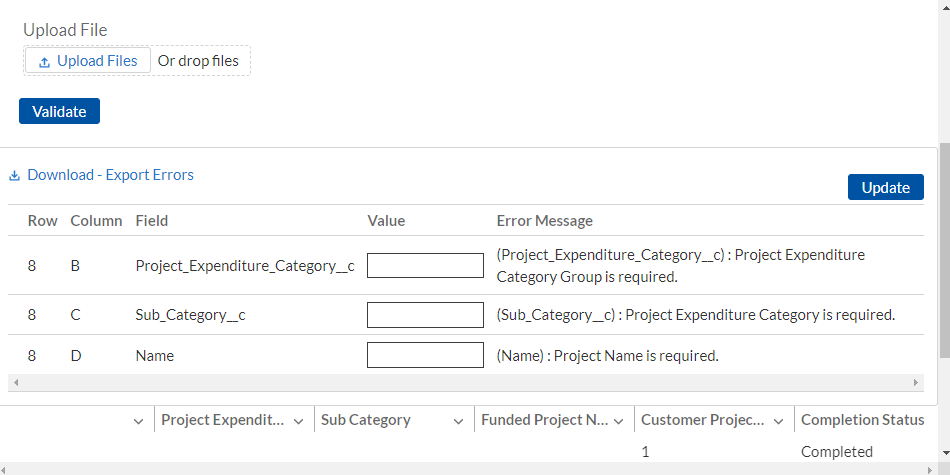
Figure 137 – Listing of Bulk Upload Errors
I
 f
the system validates that the bulk upload has no errors, it will
return the same screen as Figure 138 with instead the option to
“Create” (see Figure 138). Click the “Create”
button.
f
the system validates that the bulk upload has no errors, it will
return the same screen as Figure 138 with instead the option to
“Create” (see Figure 138). Click the “Create”
button.

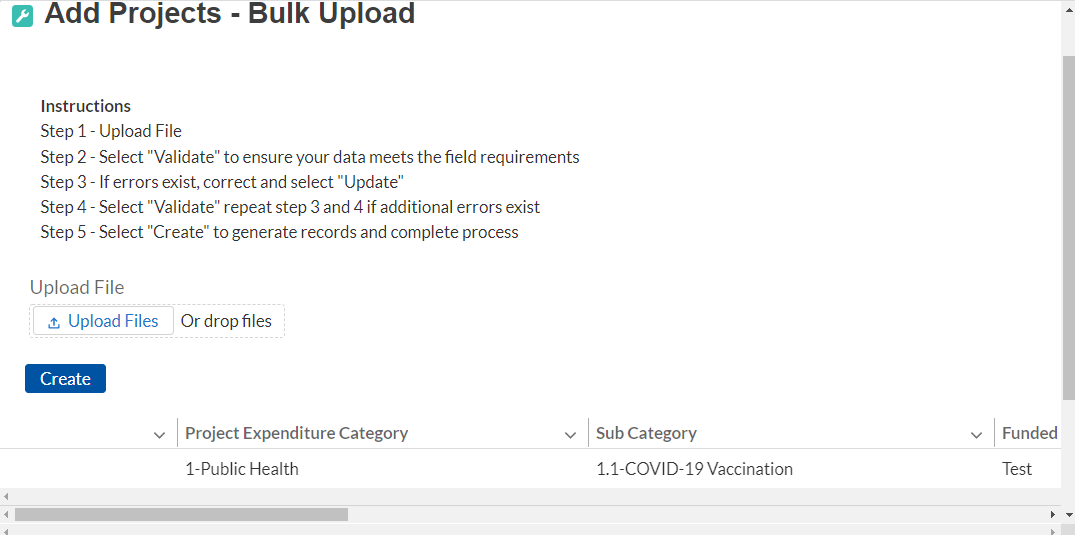
Figure 138 – Bulk Upload Creation
Once created, the records will show at the bottom of the relevant screen.
Module-To-Module Bulk Upload File Creation Steps
The collective bulk file upload process is contingent upon end-users following the below steps to ensure successful submission:
Set up a Project Record within the system.
Load the Subrecipient Profile within the Project Record
Load the Subaward Reporting next (file references Sub Recipient and Project Record information)
Load the three Expenditures files (files reference Sub Award and Project Record information)
Load the Demographic File (This step is not available for Q3 2023 quarterly reports)
Load the Participant Household Payment Data File
Note: All information submitted through the bulk upload process must be submitted as a CSV file.
CSV Guidance
Refer to the following link for descriptions of the CSV format.
https://en.wikipedia.org/wiki/Comma-separated_values
The date format is MM/DD/YYYY. Example: 06/22/2021. To maintain this required format, it may be necessary to set-up the date fields using a “custom” format found under the “Format Cells” function in Excel.
Do not include commas or special characters such as @#$%^&*( in the file
All currency values are numeric. It is not required to add “,” for thousand or millions.
Currency values should not contain a “$” sign. The file will be rejected if a “$” is included in the data entry.
All data for each template should be entered as text (except for the date fields, as noted above). Prior to entering data, users must follow the below steps:
Step 1: Select all cells within the template. The Select All button sits at the upper left of all worksheets, at the origin of row and column labels.
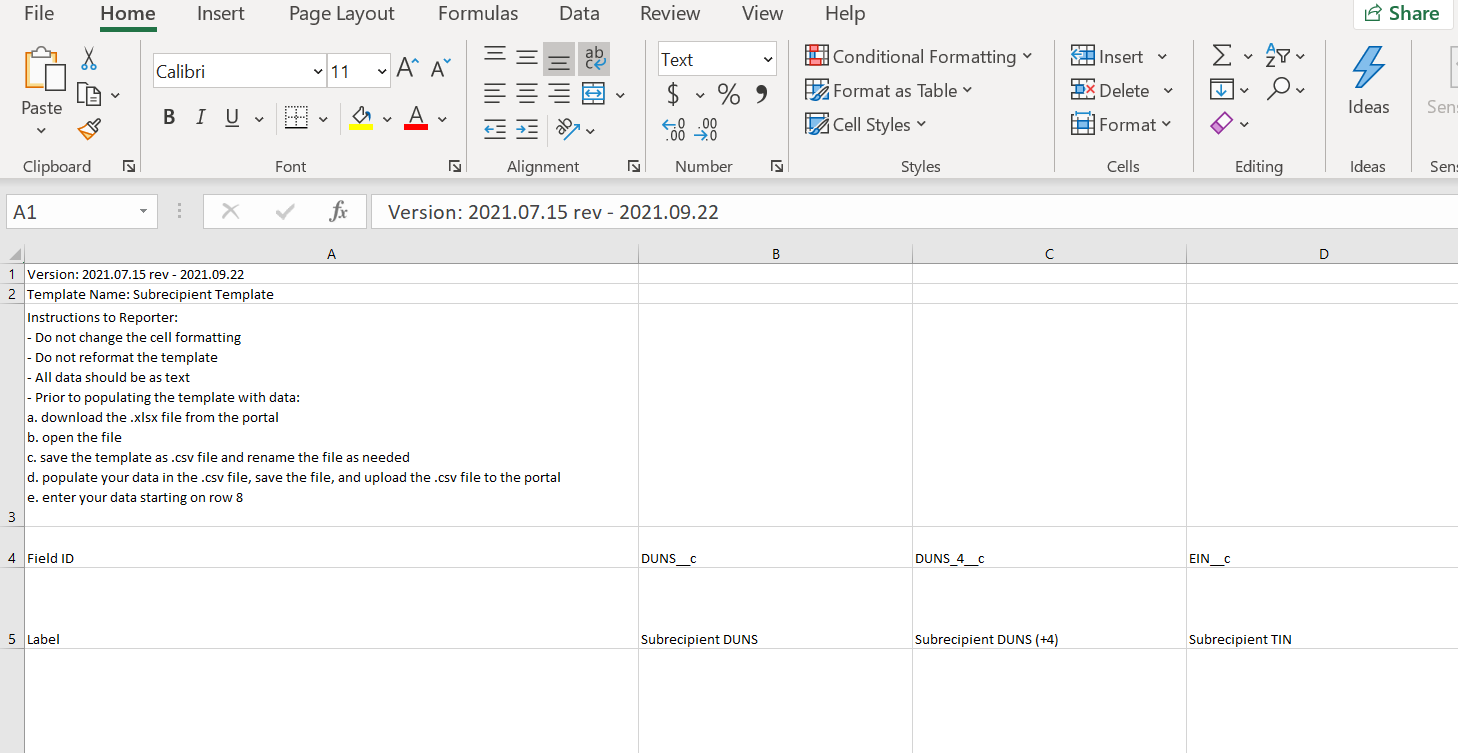
Figure 139 – Select All Button
Step 2: Click the drop-down arrow next to the Format command on the Home tab. Select Format Cells.
Step 3: Click the Number tab. Select Text as the Category.
Step 4: Click OK.
Upload Template Description
Each data element and/or column in the CSV files is described below:
Index No: Reference number for the data element. For internal use only
Defined term: Column Short description.
Definition: Column long description or definition
CSV Column Name: The column header name that must be used in the CSV file.
Required: Indicates if the column is required or not required.
List Value: The content of the column is from a list of predefined values. This is valid for some of the columns. The list is provided for all cases. Most of the cases is N/A which means that the type is ether String or Numeric
Data type: Specify the data type of the column. The options are: Numeric, Text, Date and Picklist.
Max Length: Indicates the maximum length in characters that is allowed for each column.
This module provides guidance on using bulk upload Template 1 to report information on each Subrecipient, Contractor and Beneficiaries (other than beneficiaries who are individual tenants or individual/small business landlords) to which the ERA2 Recipient obligated $30,000 or more in ERA2 funding in the reporting period. The Subrecipients, Contractors and Beneficiaries Tab allows users to enter data manually or leverage the bulk file upload capability. For a definition of “Subaward” in the context of ERA2 reporting, please see the Addendum to ERA Reporting Guidance – Clarifications and Guidance for Financial Reporting on Recipient and Subrecipient Activities.
CSV Format details
The templates provide all information required to create the upload files. The following table highlights the data elements required for the Subrecipients, Contractors, and Beneficiaries profile. Note, UEI (alpha-numeric) and TIN (numeric) cannot contain ‘-‘ , spaces, or symbols.
Table 1 – Required Data Elements for the Subrecipients, Contractors, and Beneficiaries Profile
Defined Term |
Definition |
Required |
List Values |
Data Type |
Max
|
Subrecipient UEI |
The Subrecipient, Contractor, or Beneficiary Unique Entity Identifier (UEI) from their SAM.gov profile.
|
Required for Subrecipients or Contractors
NOTE: Beneficiary must have one of the following identification numbers must be provided: -UEI, or -TIN |
n/a |
Alpha-numeric |
12 |
Subrecipient TIN |
The Subrecipient, Contractor, or Beneficiary Internal Revenue Service (IRS) Taxpayer Identification Number
|
Optional for Subrecipients or Contractors
NOTE: Beneficiary must have one of the following identification numbers must be provided: -UEI, or -TIN |
n/a |
Numeric |
9 |
Subrecipient Type |
A collection of indicators of different types of Subrecipients, Contractors, or Beneficiary types that receive ERA funds. |
Required |
|- State |- County Government |- City or Township Government |- Regional Organization |- Nonprofit with Sec 501(C)(3) IRS status (Other than an institution of Higher Education) |- Nonprofit without Sec 501(C)(3) IRS status (Other than an institution of Higher Education) |- Individual |- For-Profit Organization (Other than a Small Business) |- Small Business |- Other
|
Picklist (see permissible values in previous column) |
82 |
Subrecipient Name |
The name of the Subrecipient, Contractor, or Beneficiary. |
Required |
n/a |
String |
80 |
POC Email Address |
The email address of the primary point-of-contact for the Subrecipient Contractor, or Beneficiary. |
Required |
n/a |
String |
40 |
Address Line 1 |
First line of the Subrecipient, Contractor, or Beneficiary address. |
Required |
n/a |
String |
255 |
Address Line 2 |
Second line of the Subrecipient, Contractor, or Beneficiary address. |
Optional |
n/a |
String |
255 |
Address Line 3 |
Third line of the Subrecipient, Contractor, or Beneficiary address. |
Optional |
n/a |
String |
255 |
City Name |
Name of the city in which the Subrecipient, Contractor, or Beneficiary is located. |
Required |
n/a |
String |
100 |
State Code |
United States Postal Service (USPS) two-letter abbreviation for the state or territory in which the Subrecipient, Contractor, or Beneficiary is located. |
Required |
(AL, AK, AS, AZ, AR, CA, CO, CT, DE, DC, FM, FL, GA, GU, HI, ID, IL, IN, IA, KS, KY, LA, ME, MH, MD, MA, MI, MN, MS, MO, MT, NE, NV, NH, NJ, NM, NY, NC, ND, MP, OH, OK, OR, PW, PA, PR, RI, SC, SD, TN, TX, UT, VT, VI, VA, WA, WV, WI, WY) |
String |
2 |
Zip5 |
United States ZIP code (five digits) associated with the Subrecipient's, Contractor’s, or Beneficiaries address. |
Required |
n/a |
Numeric |
5 |
Zip4 |
United States ZIP code + 4 (four digits) associated with the Subrecipient's, Contractor's, or Beneficiaries address. Format XXXX, 4 numeric characters. |
Optional |
n/a |
Numeric |
4 |
Subrecipient SAM.gov Registration |
Confirmation that the Subrecipient or Contractor is registered in SAM.gov.
Must select Yes or No.
. |
Optional
Select N/A if you are reporting for a beneficiary. |
Yes/No |
Picklist (see permissible values in previous column) |
n/a |
In its preceding fiscal year, did recipient receive 80% or more of its annual gross revenue from federal funds? |
Confirmation that the proportion of the Subrecipient's or Contractor's federal funding-to-total annual gross revenue for the preceding fiscal year is at least 80% |
Optional
Leave blank if not applicable. |
Yes/No |
Picklist (see permissible values in previous column) |
n/a |
In the preceding fiscal year, did recipient receive $25 million or more of its annual gross revenue from federal funds? |
Confirmation that the Subrecipient's or Contractor's total annual gross revenue from federal funding across all programs for the preceding fiscal year is greater than $25 million. |
Optional
Leave blank if not applicable. |
Yes/No |
Picklist (see permissible values in previous column) |
n/a |
Is the "total compensation" for the organization's five highest paid officers publicly listed or otherwise listed in SAM.gov? |
Confirmation that qualifying Subrecipient's or Contractor's publicly identify their top five highest compensated executives or have it listed in their SAM.gov profile, if No please provide names and compensation for top 5 executives. |
Optional
Leave blank if not applicable. |
Yes/No |
Picklist (see permissible values in previous column) |
n/a |
Executive Name (1) |
The legal name belonging to one of the five highest paid executives, officers, or employees of the Subrecipient or Contractor |
Optional
Leave blank if not applicable. |
n/a |
String |
100 |
Total Compensation (1) |
The Total Compensation, as defined in 2 CFR part 170.330, earned by the five highest paid executives, officers, or employees of the Subrecipient or Contractor. |
Optional
Leave blank if not applicable. |
n/a |
Numeric |
12,2 |
Executive Name (2) |
The legal name belonging to one of the five highest paid executives, officers, or employees of the Subrecipient or Contractor. |
Optional
Leave blank if not applicable. |
n/a |
String |
100 |
Total Compensation (2) |
The Total Compensation, as defined in 2 CFR part 170.330, earned by the five highest paid executives, officers, or employees of the Subrecipient or Contractor. |
Optional
Leave blank if not applicable. |
n/a |
Numeric |
12,2 |
Executive Name (3) |
The legal name belonging to one of the five highest paid executives, officers, or employees of the Subrecipient or Contractor. |
Optional
Leave blank if not applicable. |
n/a |
String |
100 |
Total Compensation (3) |
The Total Compensation, as defined in 2 CFR part 170.330, earned by the five highest paid executives, officers, or employees of the Subrecipient or Contractor. |
Optional
Leave blank if not applicable. |
n/a |
Numeric |
12,2 |
Executive Name (4) |
The legal name belonging to one of the five highest paid executives, officers, or employees of the Subrecipient or Contractor. |
Leave blank if not applicable. |
n/a |
String |
100 |
Total Compensation (4) |
The Total Compensation, as defined in 2 CFR part 170.330, earned by the five highest paid executives, officers, or employees of the Subrecipient or Contractor. |
Optional
Leave blank if not applicable. |
n/a |
Numeric |
12,2 |
Executive Name (5) |
The legal name belonging to one of the five highest paid executives, officers, or employees of the Subrecipient or Contractor. |
Optional
Leave blank if not applicable. |
n/a |
String |
100 |
Total Compensation (5) |
The Total Compensation, as defined in 2 CFR part 170.330, earned by the five highest paid executives, officers, or employees of the Subrecipient or Contractor. |
Optional
Leave blank if not applicable. |
n/a |
Numeric |
12,2 |
This module provides guidance on using the bulk upload Template 2 to report each Subaward, Contract and Direct Payment of ERA2 funding made in the reporting period. ERA2 Recipients use Template 2 to report detailed information on the amount, date, period and place of performance, and a brief description of the Subaward, Contract, or Direct Payment and its underlying eligible use. In addition, information submitted in the Template associates each Subaward issues in the reporting period with the relevant Project /FAIN and Subrecipient.
The templates provide all information required to create the upload files. The following table highlights the data elements required for the Subawards, Contracts, and Direct Payments reporting.
Table 2 – Required Data Elements for Subawards, Contracts and Direct Payments Reporting
Defined Term |
Definition |
Required |
List Values |
Data Type |
Max
|
Subrecipient UEI |
The Subrecipient, Contractor, or Beneficiary Unique Entity Identifier (UEI) from their SAM.gov profile.
|
Required for Subrecipients or Contractors
NOTE: Beneficiary must have one of the following identification numbers must be provided: -UEI, or -TIN |
n/a |
Alpha-numeric |
12 |
Subrecipient TIN |
The Subrecipient, Contractor, or Beneficiary Internal Revenue Service (IRS) Taxpayer Identification Number
|
Optional for Subrecipients or Contractors
NOTE: Beneficiary must have one of the following identification numbers must be provided: -UEI, or -TIN |
n/a |
Numeric |
9 |
Recipient Project Id |
The Project Identification Number associated with the subaward, contract, or direct payment. |
Required |
n/a |
Numeric |
20 |
Subrecipient Name |
The name of the Subrecipient, Contractor, or Beneficiary assigned to the subaward, contract, or direct payment. NOTE: The name must match the name provided in the Subrecipient bulk upload file or the name entered in the system.
NOTE: The name must match the information provided either via bulk upload file or manually entered in the system under the Subrecipients, Contractors, and Beneficiaries. |
Required |
n/a |
String |
120 |
Subaward No. |
Recipient's internal account number for the grant, contract, transfer, or direct payment. This can be the account number, or any other unique identifying number assigned by the Recipient to the award. This number is strictly for the Recipient's recordkeeping. |
Required |
n/a |
String |
20 |
Subaward Type |
The type of Subaward.
NOTE: The ERA portal includes additional picklist values for this field. Please disregard those additional values and use the award types provided above. |
Required |
-
Contract: Purchase Order - Subaward |
Picklist (see permissible values in previous column) |
30 |
Subaward Amount (Obligation) |
Total amount of ERA funds obligated by the Recipient to a Subrecipient under a given Subaward. |
Required |
n/a |
Numeric |
12,2 |
Subaward Date |
The date the Recipient obligated funds to a Subrecipient. |
Required |
n/a |
Date |
8 |
Period of Performance Start |
The date on which efforts begin or the Subaward is otherwise effective. |
Required |
n/a |
Date |
8 |
Period of Performance End |
The date on which all effort is completed or the Subaward is otherwise ended. |
Required |
n/a |
Date |
8 |
Place of Performance Address 1 |
First line of the address where the predominant performance of the Subaward will be accomplished. |
Required |
n/a |
String |
120 |
Place of Performance Address 2 |
Second line of the address where the predominant performance of the Subaward will be accomplished. |
Optional |
n/a |
String |
120 |
Place of Performance Address 3 |
Third line of the address where the predominant performance of the Subaward will be accomplished. |
Optional |
n/a |
String |
120 |
Place of Performance City |
The name of the city where the predominant performance of the Subaward will be accomplished. |
Required |
n/a |
String |
40 |
Place of Performance State Code |
United States Postal Service (USPS) two-letter abbreviation for the state or territory indicating where the predominant performance of the Subaward will be accomplished. |
Required |
(AL, AK, AS, AZ, AR, CA, CO, CT, DE, DC, FM, FL, GA, GU, HI, ID, IL, IN, IA, KS, KY, LA, ME, MH, MD, MA, MI, MN, MS, MO, MT, NE, NV, NH, NJ, NM, NY, NC, ND, MP, OH, OK, OR, PW, PA, PR, RI, SC, SD, TN, TX, UT, VT, VI, VA, WA, WV, WI, WY) |
String |
2 |
Place of Performance Zip |
United States ZIP code (five digits) identifying where the predominant performance of the subaward will be accomplished.
|
Required |
n/a |
Numeric |
4 |
Place of Performance Zip4 |
United States ZIP code (five digits) appended to the ZIP code +4 (four digits) identifying where the predominant performance of the Subaward will be accomplished. |
Optional |
n/a |
Numeric |
5 |
Place of Performance Country |
Name of the country where the predominant performance of the Subaward will be accomplished. |
Required |
n/a |
String |
100 |
Subaward Description |
A description of the overall purpose and expected outputs and outcomes or results of the funded subaward, including significant deliverables and, if appropriate, associated units of measure. The purpose and outcomes or results should be stated in terms that allow an understanding that the subaward constitutes an eligible use of funds. |
Required |
n/a |
String |
750 |
Expenditures associated with the ERA Recipient’s Subawards, Contracts, and Direct Payments for which it has obligated $30,000 or more template
This module provides guidance on using Template 3 to report the ERA2 Recipient’s expenditures associated with its obligations of $30,000 for more for its subawards, contracts, and direct payments. Recipients are required to provide the relevant Expenditure Category, the amount of the expenditure(s) and relevant dates. In addition, recipients receiving ERA2 award funds are required to answer additional Subaward, Contract, and Direct Payment questions.
CSV Format Details
The templates provide all information required to create the upload files. The following table highlights the data elements required for Expenditures associated with Subawards, Contracts and Direct Payments for which the ERA2 Recipient had obligated $30,000 or more.
Table 3 – Required Data Elements for Expenditures associated with the ERA Recipient’s Subawards, Contracts and Direct Payments valued at $30,000.
Defined Term |
Definition |
Required |
List Values |
Data Type |
Max
|
Recipient Project Id |
Recipient Project ID that allows the Recipient to associate Expenditure records to Project records. |
Required |
n/a |
Numeric |
20 |
Subaward Number |
Subaward, Contract, or Direct Payment number that allows the Recipient to associate Expenditure records to Subaward records. The Subaward or Contract Number is not required if Expenditure Category is "Administrative Cost". |
Required |
n/a |
Numeric |
20 |
Expenditure Start Date |
Start date for the range of time when the expenditure(s) occurred. |
Required |
n/a |
Date |
8 |
Expenditure End Date |
End date for the range of time when the expenditure(s) occurred |
Required |
n/a |
Date |
8 |
Expenditure Amount |
Total amount of Emergency Rental Assistance dollars for the Subaward, Contract, or Direct Payment. |
Required |
n/a |
Numeric |
12,2 |
Expenditure Category |
The category to which the purpose of the expenditure most closely relates to when created. |
Required |
-
Financial Assistance: Rent; |
Picklist (see permissible values in previous column) |
100 |
Administrative Expense Explanation |
If Expenditure Category = Administrative Costs. An explanation up to 10,000 characters is required. |
Optional |
n/a |
String |
10000 |
Total of all obligations and total of all expenditures associated with the ERA Recipient’s Subawards, Contracts and Direct Payments valued at less than $30,000 Template
This module associates obligations and expenditures less than $30,000 for the ERA recipient’s subawards, contracts, and direct payments. Recipients are required to provide total quarterly obligation and total quarterly expenditure amounts. Ensure you accurately select Subaward, Contract, or Direct Payment for respective obligations and expenditures.
CSV Format Details
The templates provide all information required to create the upload files. The following table highlights the data elements required for Total of all obligations and total of all expenditures associated with the ERA Recipient’s Subawards, Contracts and Direct Payments valued at less than $30,000 Template.
Table 4 – Required Data Elements for Total of all obligations and total of all expenditures associated with the ERA Recipient’s Subawards, Contracts and Direct Payments valued at less than $30,000.
Defined Term |
Definition |
Required |
List Values |
Data Type |
Max
|
Recipient Project Id |
Recipient Project ID that allows the Recipient to associate Expenditure records to Project records. |
Required |
n/a |
Numeric |
20 |
Expenditure Category |
The category to which the purpose of the expenditure most closely relates to when created. |
Required |
"Financial Assistance: Rent" "Financial Assistance: Rental Arrears" "Financial Assistance: Utility/Home Energy Costs" "Financial Assistance: Utility/Home Energy Costs Arrears" "Financial Assistance: Other Housing Costs "
"Housing Stability Services (Including Eviction Prevention/Diversion)" "Administrative Costs" |
Picklist (see permissible values in previous column) |
100 |
Subaward Type (Aggregates) |
The Subaward, Contract, or Direct Payment Type that had obligation or expenditure/payment activity during the reporting period. |
Required |
"Aggregate of Contracts less than $30000"; "Aggregate of Subawards less than $30000" "Aggregate of Direct Payments less than $30000" |
Picklist (see permissible values in previous column) |
100 |
Total Quarterly Obligation Amount (Aggregates) |
Sum of amounts/obligations during the most recent quarter for this Expenditure Category (Aggregates). |
Required |
n/a |
Numeric |
12,2 |
Total Quarterly Expenditure Amount (Aggregates) |
Sum of Expenditures or Payments during the most recent quarter for this Expenditure Category (Aggregates). |
Required |
n/a |
Numeric |
12,2 |
Administrative Expense Explanation |
If Administrative Costs is selected as the expenditure category, an explanation of the expenses must be provided. |
Optional |
n/a |
String |
10000 |
Recipient Obligations and Expenditures (Payments) to Individuals (Beneficiaries) Template
This
module associates the ERA2 Recipient’s obligations and
expenditures (Payments) to individuals (Beneficiaries). ERA2
Recipients are required to provide total quarterly obligation and
total quarterly expenditure amounts.
CSV Format Details
The templates provide all information required to create the upload files. The following table highlights the data elements required for Recipient Obligations and Expenditures (Payments) to Individuals (Beneficiaries) Template.
.
Table 5 – Required Data Elements for Recipient Obligations and Expenditures (Payments) to Individuals (Beneficiaries)
Defined Term |
Definition |
Required |
List Values |
Data Type |
Max
|
Recipient Project Id |
Recipient Project ID that allows the Recipient to associate Expenditure records to Project records. |
Required |
n/a |
Numeric |
20 |
Expenditure Category |
The category to which the purpose of the expenditure most closely relates to when created. |
Required |
"Financial Assistance: Rent" "Financial Assistance: Rental Arrears" "Financial Assistance: Utility/Home Energy Costs" "Financial Assistance: Utility/Home Energy Costs Arrears" "Financial Assistance: Other Housing Costs ""Housing Stability Services (Including Eviction Prevention/Diversion)" "Administrative Costs" |
Picklist (see permissible values in previous column) |
100 |
Total Quarterly Obligation Amount (Aggregates) |
Sum of amounts/obligations during the most recent quarter for this Expenditure Category (Aggregates). |
Required |
n/a |
Numeric |
12,2 |
Total Quarterly Expenditure Amount (Aggregates) |
Sum of Expenditures or Payments during the most recent quarter for this Expenditure Category (Aggregates). |
Required |
n/a |
Numeric |
12,2 |
Administrative Expense Explanation |
If Administrative Costs is selected as the expenditure category, an explanation of the expense must be provided |
Optional |
n/a |
String |
10,000 |
Participant Household Payment Data File Template
All ERA2 Recipients must submit a Participant Household Payment Data File (PHPDF) containing required information about each ERA2 Financial Assistance payment made to or on behalf of each participant household during the reporting period. See the chart below for details on the required information.
Users must use the Treasury-provided template for the PHPDF and submit the file using the bulk upload process. There is not an option to provide the information manually; all Recipients must provide the Participant Household Payment Data file via bulk upload.
CSV Format Details
The templates provide all information required to create the upload files. The following table highlights the data elements required for Participant Household Payment Data. The “Participant Household” address fields should include the physical address for each Project Participant Household (i.e., tenant) that received ERA Financial Assistance either directly or through a payment made to their landlord, utility/home energy provider, or other service provider. The address should be for the ultimate beneficiary of the services.
Table 7 – Required Data Elements for Participant Household Payment Data File
Defined Term |
Definition |
Required |
List Values |
Data Type |
Max
|
Address Line 1 |
First line of the Participant Household’s physical address (not a P.O. Box) |
Required |
n/a |
String |
120 |
Address Line 2 |
Second line of the Participant Household’s physical address (Not a P.O. Box) |
Optional |
n/a |
String |
120 |
Address Line 3 |
Third line of the Participant Household’s physical address (Not a P.O. Box) |
Optional |
n/a |
String |
120 |
City Name |
The name of the city where the Participant Household’s physical address is located |
Required |
n/a |
String |
40 |
State Code |
United States Postal Service (USPS) two-letter abbreviation for the state or territory indicating the Participant Household’s state |
Required |
n/a |
String |
2 |
Zip5 |
United States ZIP code (five digits) appended to the ZIP code +4 (four digits) identifying the Participant Household’s address. |
Required |
n/a |
String |
5 |
Zip4 |
Zip Plus4 (four digits) identifying the physical address of the Participant Household. |
Optional |
n/a |
String |
4 |
Payee Type |
A collection of indicators of different types of payees |
Required |
Tenant; Landlord or Owner; Utility/Home Energy Service Provider; Other Housing Services and Eligible Expenses Provider |
Picklist (see permissible values in previous column) |
120 |
Amount of Payment |
Total amount of ERA funds disbursed to the payee |
Required |
n/a |
Dollar Numeric |
12,2 |
Date of Payment |
The date the payment was disbursed to the payee |
Required |
n/a |
Date Numeric |
8 |
Type of Assistance Covered by the Payment |
A collection of indicators of different types of assistance |
Required |
- Financial Assistance: Rent; - Financial Assistance: Rental Arrears; - Financial Assistance: Utility/Home Energy Costs; - Financial Assistance: Utility/Home Energy Costs Arrears; - Financial Assistance: Other Housing Costs |
Picklist (see permissible values in previous column) |
120 |
Start Date Covered by the Payment |
Start date the Financial Assistance covers for a particular household |
Required |
n/a |
Date Numeric |
8 |
End Date Covered by the Payment |
End date the Financial Assistance covers for a particular household |
Required |
n/a |
Date Numeric |
8 |
Appendix B – Total Quarterly Obligations and Expenditures Associated with the ERA2 Recipient’s Subawards, Contracts and Direct Payments Valued at Less than $30,000
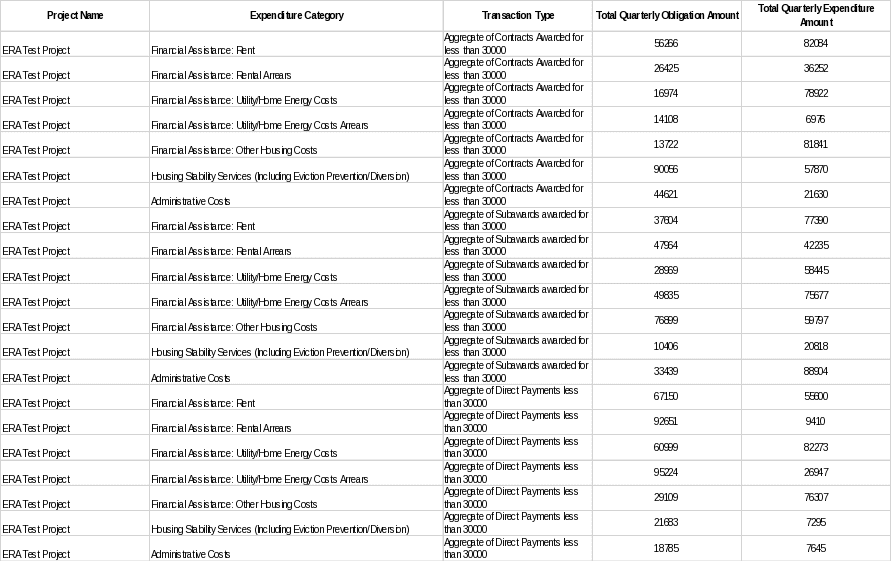
Appendix C – Recipient Obligations and Expenditures (Payments) to Individuals (Beneficiaries)

Appendix D – Treatment of Contractors with Initial Obligations Less than $30,000 in One Reporting Period that Increases to $30,000+ in a Subsequent Reporting Period
ERA2 Recipients often make multiple subawards or contracts to a single entity. When the first contract is for less than $30,000, the ERA2 Recipient should report the expenditure as one associated with a contract valued at less than $30,000. However, if a subsequent obligation increases the value of the contract to more than $30,000, the ERA2 Recipient needs to report all payments to that Contractor as expenditures associated with Contracts valued at $30,000 or more. As a result, the ERA2 Recipient will need to adjust the original expenditure reporting.
Example: Contractor XYZ was awarded a contract valued at $20k in Q3 and is paid the full amount in Q3. The expenditure to XYZ should be reported in Q3 under “Total of all Obligations and Total of all Expenditures Associated with the ERA Recipient’s Subawards, Contracts, and Direct Payments Valued at Less than $30,000” aggregated with other expenditures under the relevant “Expenditure Category” and contract type “Subaward, Contract or Direct Payment Type (Aggregates).”
In Q4, the ERA2 recipient enters into a new contract, or modifies the initial contract with Contractor XYZ for an additional $20k of services, so the total award/amount obligated to XYZ is greater than $30,000. In Q4 the Recipient must create 1) a Subrecipient profile under “Subrecipients, Contractors, and Beneficiaries” for XYZ and 2) one contract record for each contract the recipient has or previously had with XYZ under “Recipient Subawards, Contracts, and Direct Payments.” Contract records will include the total amount obligated under the contract (expended to date and committed for future payment) in the “Amount Obligated” field.
Since payments to Contractor XYZ will now be reported as expenditures of $30,000 or more, in order to avoid double-counting previous entries under “Subaward, Contract or Direct Payment Type (Aggregates)”, a negative entry (-$20k) should be reported in the current quarter quarterly report (with a note under the ‘Administrative Cost Narrative’ to clarify the reason for the negative entry) under “Total of all Obligations and Total of all Expenditures Associated with the ERA2 Recipient’s Subawards, Contracts, and Direct Payments Valued at Less than $30,000” under the relevant “Expenditure Category” and contract type “Subaward, Contract or Direct Payment Type (Aggregates).”
Finally, all expenditures to date and going forward for Contractor XYZ under this ERA Award should now be entered under “Expenditures Associated with the ERA Recipient’s Subawards, Contracts and Direct Payments Valued at $30,000 or More” under the relevant “Expenditure Category.”
Emergency Rental Assistance (ERA2) Program
User Guide - Treasury’s Portal for ERA2 Recipient Reporting
| File Type | application/vnd.openxmlformats-officedocument.wordprocessingml.document |
| Author | Carriker, Charles (Contractor) |
| File Modified | 0000-00-00 |
| File Created | 2025-08-07 |
© 2025 OMB.report | Privacy Policy


